
List of birds of Gibraltar
Encyclopedia
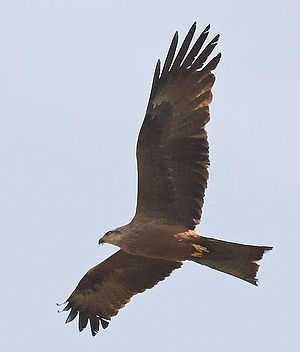
Gibraltar
Gibraltar is a British overseas territory located on the southern end of the Iberian Peninsula at the entrance of the Mediterranean. A peninsula with an area of , it has a northern border with Andalusia, Spain. The Rock of Gibraltar is the major landmark of the region...
includes a total of 311 species, of which seven have been introduced
Introduced species
An introduced species — or neozoon, alien, exotic, non-indigenous, or non-native species, or simply an introduction, is a species living outside its indigenous or native distributional range, and has arrived in an ecosystem or plant community by human activity, either deliberate or accidental...
by humans, and 128 are rare or accidental in Gibraltar. Five species are globally threatened.
This list's taxonomic
Taxonomy
Taxonomy is the science of identifying and naming species, and arranging them into a classification. The field of taxonomy, sometimes referred to as "biological taxonomy", revolves around the description and use of taxonomic units, known as taxa...
treatment (designation and sequence of orders, families, and species) and nomenclature (common and scientific names) follow the conventions of Clements
James Clements
Dr. James Franklin Clements was an ornithologist, author and very successful businessman. He was born in New York....
's 5th edition with a few changes to match the list of the Gibraltar Ornithological & Natural History Society
Gibraltar Ornithological & Natural History Society
The Gibraltar Ornithological & Natural History Society , founded in 1976, is a non-governmental, membership-based organisation committed to research into and conservation of nature in Gibraltar and the region of the Strait of Gibraltar....
. The family accounts at the beginning of each heading reflect the Clements taxonomy, as do the species counts found in each family account. Introduced and accidental species are included in the total counts for Gibraltar.
The following tags have been used to highlight certain relevant categories. The commonly occurring, native, species do not fall into any of these categories.
- (A) Accidental A species that rarely or accidentally occurs in Gibraltar.
- (I) Introduced A species which occurs in Gibraltar as a consequence, direct or indirect, of human actions. The majority of these are wanderers from introduced populations in Spain.
| Table of contents |
|---|
Non-passerines: Divers . Grebes . Shearwaters and petrels . Storm-petrels . Gannets . Cormorants . Herons, egrets and bitterns . Storks . Ibises and spoonbills . Flamingos . Ducks and geese . Osprey . Hawks, kites and eagles . Falcons . Pheasants and partridges . Cranes . Rails, gallinules, and coots . Bustards . Oystercatchers . Avocets and stilts . Thick-knees . Pratincoles and coursers . Plovers and lapwings . Sandpipers and allies . Skuas . Gulls . Terns . Auks . Sandgrouse . Pigeons and doves . Cuckoos . Barn owls . Typical owls . Nightjars . Swifts . Kingfishers . Bee-eaters . Rollers . Hoopoes . Woodpeckers and allies . |
Passerines: Larks . Swallows and martins . Wagtails and pipits . Kinglets . Wrens . Accentors . Thrushes and allies . Cisticolas and allies . Old World warblers and chats . Old World flycatchers . Long-tailed tits . Tits . Wallcreeper . Treecreepers . Old World orioles . Shrikes . Crows, jays, ravens and magpies . Starlings . Weavers and allies . Waxbills and allies . Buntings and New World sparrows . New World blackbirds . Finches . Sparrows . |
See also References |
Divers
Order: GaviiformesGaviiformes
Gaviiformes is an order of aquatic birds containing the loons or divers and their closest extinct relatives. Modern gaviiformes are found in many parts of North America and northern Eurasia , though prehistoric species were more widespread.-Classification and evolution:There are five living...
Family: Gaviidae
Divers, known as loons in North America, are group of aquatic birds found in many parts of North America and northern Europe. They are the size of a large duck or small goose, which they somewhat resembles in shape when swimming, but they completely unrelated to these waterfowl. There are 5 species worldwide and 3 species which occur in Gibraltar.
- Red-throated DiverRed-throated DiverThe Red-throated Loon or Red-throated Diver is a migratory aquatic bird found in the northern hemisphere. It breeds primarily in Arctic regions, and winters in northern coastal waters. It is the most widely distributed member of the loon or diver family. Ranging from in length, the Red-throated...
Gavia stellata (A) - Black-throated DiverBlack-throated DiverThe Black-throated Loon is a migratory aquatic bird found in the northern hemisphere. The species is known as an Arctic Loon in North America and the Black-throated Diver in Eurasia, its current name is a compromise proposed by the International Ornithological Committee.-Taxonomy:The...
Gavia arctica (A) - Great Northern DiverGreat Northern DiverThe Great Northern Loon, Great Northern Diver, or Common Loon , is a large member of the loon, or diver, family of birds...
Gavia immer (A)
Grebes
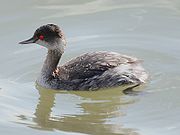
Family: Podicipedidae
Grebe
Grebe
A grebe is a member of the Podicipediformes order, a widely distributed order of freshwater diving birds, some of which visit the sea when migrating and in winter...
s are small to medium-large sized freshwater diving birds. They have lobed toes, and are excellent swimmers and divers. However, they have their feet placed far back on the body, making them quite ungainly on land. There are 20 species worldwide and 2 species which occur in Gibraltar.
- Little GrebeLittle GrebeThe Little Grebe , also known as Dabchick, member of the grebe family of water birds. At 23 to 29 cm in length it is the smallest European member of its family. It is commonly found in open bodies of water across most of its range.-Description:The Little Grebe is a small water bird with a pointed...
Tachybaptus ruficollis (A) - Black-necked GrebeBlack-necked GrebeThe Black-necked Grebe, Podiceps nigricollis, known in North America as the Eared Grebe, is a member of the grebe family of water birds. It occurs on every continent except Australia and Antarctica.-Taxonomy:There are three subspecies:*P. n...
Podiceps nigricollis
Shearwaters and petrels
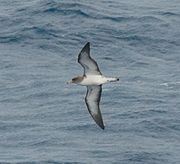
Procellariiformes
Procellariiformes is an order of seabirds that comprises four families: the albatrosses, petrels and shearwaters, storm petrels, and diving petrels...
Family: Procellariidae
Procellariidae
The family Procellariidae is a group of seabirds that comprises the fulmarine petrels, the gadfly petrels, the prions, and the shearwaters. This family is part of the bird order Procellariiformes , which also includes the albatrosses, the storm-petrels, and the diving petrels.The procellariids are...
The procellariids are the main group of medium-sized 'true petrels', characterised by united nostrils with a medium septum, and a long outer functional primary. There are 75 species worldwide and 7 species which occur in Gibraltar.
- Cape PetrelCape PetrelThe Cape Petrel also called Cape Pigeon or Pintado Petrel, is a common seabird of the Southern Ocean from the family Procellariidae. It is the only member of the genus Daption, and is allied to the fulmarine petrels, and the Giant Petrels. It is also sometimes known as the Cape Fulmar...
Daption capense (A) - Cory's ShearwaterCory's ShearwaterThe Cory's Shearwater is a large shearwater in the seabird family Procellariidae.This species breeds on islands and cliffs in the Mediterranean, with the odd outpost on the Atlantic coast of Iberia. The nest is on open ground or among rocks or less often in a burrow where one white egg is laid,...
Calonectris diomedea - Great ShearwaterGreat ShearwaterThe Great Shearwater is a large shearwater in the seabird family Procellariidae. Its relationships are unclear. It belongs in the group of large species that could be separated as genus Ardenna ; within these, it might be allied with the other black-billed, blunt-tailed species Short-tailed...
Puffinus gravis - Sooty ShearwaterSooty ShearwaterThe Sooty Shearwater is a medium-large shearwater in the seabird family Procellariidae. In New Zealand it is also known by its Māori name tītī and as "muttonbird", like its relatives the Wedge-tailed Shearwater and the Australian Short-tailed Shearwater The Sooty Shearwater (Puffinus griseus) is...
Puffinus griseus - Balearic ShearwaterBalearic ShearwaterThe Balearic Shearwater is a medium-sized shearwater in the seabird family Procellariidae. It was long regarded a subspecies of the Manx Shearwater; see there for more on the Puffinus puffinus superspecies; following an initial split it was held to be a subspecies of the "Mediterranean Shearwater"...
Puffinus mauretanicus - Levantine Shearwater Puffinus yelkouan
- Macaronesian Shearwater Puffinus baroli (A)
Storm-petrels

Procellariiformes
Procellariiformes is an order of seabirds that comprises four families: the albatrosses, petrels and shearwaters, storm petrels, and diving petrels...
Family: Hydrobatidae
The storm-petrel
Storm-petrel
Storm petrels are seabirds in the family Hydrobatidae, part of the order Procellariiformes. These smallest of seabirds feed on planktonic crustaceans and small fish picked from the surface, typically while hovering. The flight is fluttering and sometimes bat-like.Storm petrels have a cosmopolitan...
s are relatives of the petrel
Petrel
Petrels are tube-nosed seabirds in the bird order Procellariiformes. The common name does not indicate relationship beyond that point, as "petrels" occur in three of the four families within that group...
s, and are the smallest of sea-birds. They feed on plankton
Plankton
Plankton are any drifting organisms that inhabit the pelagic zone of oceans, seas, or bodies of fresh water. That is, plankton are defined by their ecological niche rather than phylogenetic or taxonomic classification...
ic crustaceans and small fish picked from the surface, typically while hovering. The flight is fluttering and sometimes bat
Bat
Bats are mammals of the order Chiroptera "hand" and pteron "wing") whose forelimbs form webbed wings, making them the only mammals naturally capable of true and sustained flight. By contrast, other mammals said to fly, such as flying squirrels, gliding possums, and colugos, glide rather than fly,...
-like. There are 21 species worldwide and 2 species which occur in Gibraltar.
- European Storm-PetrelEuropean Storm-petrelThe European Storm Petrel or Storm Petrel is a small bird of the storm-petrel family, Hydrobatidae, part of the seabird order Procellariiformes. It is the only member of the genus Hydrobates.-Description:...
Hydrobates pelagicus - Leach's Storm-PetrelLeach's Storm-petrelThe Leach's Storm Petrel or Leach's Petrel is a small seabird of the tubenose family. It is named after the British zoologist William Elford Leach....
Oceanodroma leucorhoa
Gannets
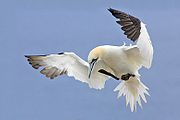
Pelecaniformes
The Pelecaniformes is a order of medium-sized and large waterbirds found worldwide. As traditionally—but erroneously—defined, they encompass all birds that have feet with all four toes webbed. Hence, they were formerly also known by such names as totipalmates or steganopodes...
Family: Sulidae
Sulidae
The bird family Sulidae comprises the gannets and boobies. Collectively called sulidas, they are medium-large coastal seabirds that plunge-dive for fish and similar prey. The ten species in this family are often considered congeneric in older sources, placing all in the genus Sula...
The sulids comprise the gannet
Gannet
Gannets are seabirds comprising the genus Morus, in the family Sulidae, closely related to the boobies.The gannets are large black and white birds with yellow heads. They have long pointed wings and long bills. Northern gannets are the largest seabirds in the North Atlantic, with a wingspan of up...
s and boobies
Booby
A booby is a seabird in the genus Sula, part of the Sulidae family. Boobies are closely related to the gannets , which were formerly included in Sula.-Description:...
. Both groups comprise medium-to-large coastal sea-birds that plunge-dive for fish. There are 9 species worldwide and 1 species which occurs in Gibraltar.
- Northern GannetNorthern GannetThe Northern Gannet is a seabird and is the largest member of the gannet family, Sulidae.- Description :Young birds are dark brown in their first year, and gradually acquire more white in subsequent seasons until they reach maturity after five years.Adults are long, weigh and have a wingspan...
Morus bassanus
Cormorants

Pelecaniformes
The Pelecaniformes is a order of medium-sized and large waterbirds found worldwide. As traditionally—but erroneously—defined, they encompass all birds that have feet with all four toes webbed. Hence, they were formerly also known by such names as totipalmates or steganopodes...
Family: Phalacrocoracidae
The Phalacrocoracidae is a family of medium-to-large coastal, fish-eating sea-birds that includes cormorants and shags. Plumage colouration varies with the majority having mainly dark plumage, some species being black and white, and a few being colourful. There are 38 species worldwide and 2 species which occur in Gibraltar.
- Great CormorantGreat CormorantThe Great Cormorant , known as the Great Black Cormorant across the Northern Hemisphere, the Black Cormorant in Australia and the Black Shag further south in New Zealand, is a widespread member of the cormorant family of seabirds...
Phalacrocorax carbo - European Shag Phalacrocorax aristotelis
Herons, egrets and bitterns
Order: CiconiiformesCiconiiformes
Traditionally, the order Ciconiiformes has included a variety of large, long-legged wading birds with large bills: storks, herons, egrets, ibises, spoonbills, and several others. Ciconiiformes are known from the Late Eocene...
Family: Ardeidae
The family Ardeidae contains the bittern
Bittern
Bitterns are a classification of birds in the heron family, Ardeidae, a family of wading birds. Species named bitterns tend to be the shorter-necked, often more secretive members of this family...
s, heron
Heron
The herons are long-legged freshwater and coastal birds in the family Ardeidae. There are 64 recognised species in this family. Some are called "egrets" or "bitterns" instead of "heron"....
s and egret
Egret
An egret is any of several herons, most of which are white or buff, and several of which develop fine plumes during the breeding season. Many egrets are members of the genera Egretta or Ardea which contain other species named as herons rather than egrets...
s. Herons and egrets are medium to large sized wading birds with long necks and legs. Bitterns tend to be shorter necked and more wary. Unlike other long-necked birds suck as storks, ibises and spoonbills, members of Ardeidae fly with their necks retracted. There are 61 species worldwide and 7 species which occur in Gibraltar.
- Grey HeronGrey HeronThe Grey Heron , is a wading bird of the heron family Ardeidae, native throughout temperate Europe and Asia and also parts of Africa. It is resident in the milder south and west, but many birds retreat in winter from the ice in colder regions...
Ardea cinerea - Purple HeronPurple HeronThe Purple Heron is a wading bird in the heron family Ardeidae, breeding in Africa, central and southern Europe, and southern and eastern Asia. The European populations are migratory, wintering in tropical Africa; the more northerly Asian populations also migrate further south within Asia...
Ardea purpurea - Little EgretLittle EgretThe Little Egret is a small white heron. It is the Old World counterpart to the very similar New World Snowy Egret.-Subspecies:Depending on authority, two or three subspecies of Little Egret are currently accepted....
Egretta garzetta - Squacco HeronSquacco HeronThe Squacco Heron, Ardeola ralloides, is a small heron, long, of which the body is , with wingspan. It is of Old World origins, breeding in southern Europe and the Greater Middle East.-Behaviour:...
Ardeola ralloides (A) - Cattle EgretCattle EgretThe Cattle Egret is a cosmopolitan species of heron found in the tropics, subtropics and warm temperate zones. It is the only member of the monotypic genus Bubulcus, although some authorities regard its two subspecies as full species, the Western Cattle Egret and the Eastern Cattle Egret...
Bubulcus ibis - Black-crowned Night-Heron Nycticorax nycticorax
- Little BitternLittle BitternThe Little Bittern is a wading bird in the heron family Ardeidae, native to the Old World, breeding in Africa, central and southern Europe, western and southern Asia, and Madagascar. Birds from temperate regions in Europe and western Asia are migratory, wintering in Africa and further south in...
Ixobrychus minutus (A)
Storks
Ciconiiformes
Traditionally, the order Ciconiiformes has included a variety of large, long-legged wading birds with large bills: storks, herons, egrets, ibises, spoonbills, and several others. Ciconiiformes are known from the Late Eocene...
Family: Ciconiidae
Storks are large, long-legged, long-necked, wading birds with long, stout bills. Storks are mute; bill-clattering is an important mode of stork communication at the nest. Their nests can be large and may be reused for many years. Many species are migratory. There are 19 species worldwide and 2 species which occur in Gibraltar.
- Black StorkBlack StorkThe Black Stork Ciconia nigra is a large wading bird in the stork family Ciconiidae. It is a widespread, but rare, species that breeds in the warmer parts of Europe, predominantly in central and eastern regions. This is a shy and wary species, unlike the closely related White Stork. It is seen in...
Ciconia nigra - White StorkWhite StorkThe White Stork is a large bird in the stork family Ciconiidae. Its plumage is mainly white, with black on its wings. Adults have long red legs and long pointed red beaks, and measure on average from beak tip to end of tail, with a wingspan...
Ciconia ciconia
Ibises and spoonbills
Order: CiconiiformesCiconiiformes
Traditionally, the order Ciconiiformes has included a variety of large, long-legged wading birds with large bills: storks, herons, egrets, ibises, spoonbills, and several others. Ciconiiformes are known from the Late Eocene...
Family: Threskiornithidae
Threskiornithidae
The family Threskiornithidae includes 34 species of large terrestrial and wading birds, falling into two subfamilies, the ibises and the spoonbills. It was formerly known as Plataleidae. The spoonbills and ibises were once thought to be related to other groups of long-legged wading birds in the...
The Threskiornithidae is a family of large terrestrial and wading birds which includes the ibis
Ibis
The ibises are a group of long-legged wading birds in the family Threskiornithidae....
es and spoonbill
Spoonbill
Spoonbills are a group of large, long-legged wading birds in the family Threskiornithidae, which also includes the Ibises.All have large, flat, spatulate bills and feed by wading through shallow water, sweeping the partly opened bill from side to side...
s. They have long, broad wings with 11 primary and about 20 secondary feathers. They are strong fliers and despite their size and weight, very capable soarers. There are 36 species worldwide and 2 species which occur in Gibraltar.
- Glossy IbisGlossy IbisThe Glossy Ibis is a wading bird in the ibis family Threskiornithidae.This is the most widespread ibis species, breeding in scattered sites in warm regions of Europe, Asia, Africa, Australia, and the Atlantic and Caribbean region of the Americas...
Plegadis falcinellus (A) - Eurasian Spoonbill Platalea leucorodia (A)
Flamingos
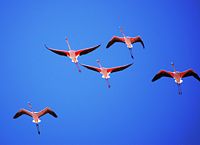
Family: Phoenicopteridae
Flamingo
Flamingo
Flamingos or flamingoes are gregarious wading birds in the genus Phoenicopterus , the only genus in the family Phoenicopteridae...
s are gregarious wading birds, usually 3 to 5 feet (1.5 m) high, found in both the Western and Eastern Hemispheres. They are more numerous in the latter. Flamingos filter-feed on shellfish and algae. Their oddly-shaped beaks are specially adapted to separate mud and silt from the food they consume, and are uniquely used upside-down. There are 6 species worldwide and 1 species which occurs in Gibraltar.
- Greater FlamingoGreater FlamingoThe Greater Flamingo is the most widespread species of the flamingo family. It is found in parts of Africa, southern Asia , and southern Europe...
Phoenicopterus roseus
Ducks, geese and swans
Order: AnseriformesAnseriformes
The order Anseriformes contains about 150 living species of birds in three extant families: the Anhimidae , Anseranatidae , and the Anatidae, which includes over 140 species of waterfowl, among them the ducks, geese, and swans.All species in the order are highly adapted for an aquatic existence at...
Family: Anatidae
Anatidae
Anatidae is the biological family of birds that includes ducks, geese and swans. The family has a cosmopolitan distribution, occurring on all the world's continents except Antarctica and on most of the world's islands and island groups...
The family Anatidae includes the duck
Duck
Duck is the common name for a large number of species in the Anatidae family of birds, which also includes swans and geese. The ducks are divided among several subfamilies in the Anatidae family; they do not represent a monophyletic group but a form taxon, since swans and geese are not considered...
s and most duck-like waterfowl, such as geese
Goose
The word goose is the English name for a group of waterfowl, belonging to the family Anatidae. This family also includes swans, most of which are larger than true geese, and ducks, which are smaller....
and swan
Swan
Swans, genus Cygnus, are birds of the family Anatidae, which also includes geese and ducks. Swans are grouped with the closely related geese in the subfamily Anserinae where they form the tribe Cygnini. Sometimes, they are considered a distinct subfamily, Cygninae...
s. These are birds that are modified for an aquatic existence with webbed feet, flattened bills and feathers that are excellent at shedding water due to an oily coating. There are 131 species worldwide and 12 species which occur in Gibraltar.
- Greylag GooseGreylag GooseThe Greylag Goose , Anser anser, is a bird with a wide range in the Old World. It is the type species of the genus Anser....
Anser anser (A) - Common ShelduckCommon ShelduckThe Common Shelduck is a waterfowl species shelduck genus Tadorna. It is widespread and common in Eurasia, mainly breeding in temperate and wintering in subtropical regions; in winter, it can also be found in the Maghreb...
Tadorna tadorna (A) - Eurasian Wigeon Anas penelope (A)
- GadwallGadwallThe Gadwall is a common and widespread duck of the family Anatidae.- Description :The Gadwall is 46–56 cm long with a 78–90 cm wingspan. The male is slightly larger than the female, weighing on average 990 g against her 850 g...
Anas strepera (A) - Eurasian Teal Anas crecca (A)
- MallardMallardThe Mallard , or Wild Duck , is a dabbling duck which breeds throughout the temperate and subtropical Americas, Europe, Asia, and North Africa, and has been introduced to New Zealand and Australia....
Anas platyrhynchos (A) - Northern PintailNorthern PintailThe Pintail or Northern Pintail is a widely occurring duck which breeds in the northern areas of Europe, Asia and North America. It is strongly migratory and winters south of its breeding range to the equator...
Anas acuta (A) - GarganeyGarganeyThe Garganey is a small dabbling duck. It breeds in much of Europe and western Asia, but is strictly migratory, with the entire population moving to southern Africa, India Santragachi and Australasia in winter, where large flocks can occur. This species was first described by Linnaeus in 1758...
Anas querquedula (A) - Tufted DuckTufted DuckThe Tufted Duck, Aythya fuligula, is a medium-sized diving duck with a population of close to one million birds.- Description :The adult male is all black except for white flanks and a blue-grey bill. It has an obvious head tuft that gives the species its name.The adult female is brown with paler...
Aythya fuligula (A) - Greater ScaupGreater ScaupThe Greater Scaup , just Scaup in Europe, or colloquially known as "Bluebill", for its bright blue bill, is small compared to other diving ducks, however it is larger than the closely related Lesser Scaup...
Aythya marila (A) - Common ScoterCommon ScoterThe Common Scoter is a large sea duck, 43-54 cm in length, which breeds over the far north of Europe and Asia east to the Olenyok River. The American/E Siberian M. americana is sometimes considered a subspecies of M. nigra.It winters further south in temperate zones, on the coasts of Europe as...
Melanitta nigra - Red-breasted MerganserRed-breasted MerganserThe Red-breasted Merganser is a diving duck.-Taxonomy:The Red-breasted Merganser was one of the many species originally described by Linnaeus in his 18th-century work, Systema Naturae.-Description:...
Mergus serrator (A)
Osprey
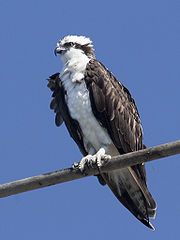
Falconiformes
The order Falconiformes is a group of about 290 species of birds that comprises the diurnal birds of prey. Raptor classification is difficult and the order is treated in several ways.- Classification problems :...
Family: Pandionidae
The Pandionidae family contains only one species, the Osprey. The Osprey is a medium large raptor
Bird of prey
Birds of prey are birds that hunt for food primarily on the wing, using their keen senses, especially vision. They are defined as birds that primarily hunt vertebrates, including other birds. Their talons and beaks tend to be relatively large, powerful and adapted for tearing and/or piercing flesh....
which is a specialist fish-eater with a worldwide distribution.
- OspreyOspreyThe Osprey , sometimes known as the sea hawk or fish eagle, is a diurnal, fish-eating bird of prey. It is a large raptor, reaching more than in length and across the wings...
Pandion haliaetus
Hawks, kites and eagles

Falconiformes
The order Falconiformes is a group of about 290 species of birds that comprises the diurnal birds of prey. Raptor classification is difficult and the order is treated in several ways.- Classification problems :...
Family: Accipitridae
Accipitridae
The Accipitridae, one of the two major families within the order Accipitriformes , are a family of small to large birds with strongly hooked bills and variable morphology based on diet. They feed on a range of prey items from insects to medium-sized mammals, with a number feeding on carrion and a...
Accipitridae is a family of birds of prey and include hawk
Hawk
The term hawk can be used in several ways:* In strict usage in Australia and Africa, to mean any of the species in the subfamily Accipitrinae, which comprises the genera Accipiter, Micronisus, Melierax, Urotriorchis and Megatriorchis. The large and widespread Accipiter genus includes goshawks,...
s, eagle
Eagle
Eagles are members of the bird family Accipitridae, and belong to several genera which are not necessarily closely related to each other. Most of the more than 60 species occur in Eurasia and Africa. Outside this area, just two species can be found in the United States and Canada, nine more in...
s, kites
Kite (bird)
Kites are raptors with long wings and weak legs which spend a great deal of time soaring. Most feed mainly on carrion but some take various amounts of live prey.They are birds of prey which, along with hawks and eagles, are from the family Accipitridae....
, harriers
Harrier (bird)
A harrier is any of the several species of diurnal hawks forming the Circinae sub-family of the Accipitridae family of birds of prey. Harriers characteristically hunt by flying low over open ground, feeding on small mammals, reptiles, or birds....
and Old World vultures. These birds have powerful hooked beaks for tearing flesh from their prey, strong legs, powerful talons, and keen eyesight. There are 233 species worldwide and 24 species which occur in Gibraltar.
- European Honey-buzzard Pernis apivorus
- Black-shouldered KiteBlack-shouldered KiteThe Black-shouldered Kite or Australian Black-shouldered Kite is a small raptor found in open habitat throughout Australia and resembles similar species found in Eurasia and North America, which have in the past also been named as Black-shouldered Kites...
Elanus caeruleus (A) - Red KiteRed KiteThe Red Kite is a medium-large bird of prey in the family Accipitridae, which also includes many other diurnal raptors such as eagles, buzzards, and harriers. The species is currently endemic to the Western Palearctic region in Europe and northwest Africa, though formerly also occurred just...
Milvus milvus - Black KiteBlack KiteThe Black Kite is a medium-sized bird of prey in the family Accipitridae, which also includes many other diurnal raptors. Unlike others of the group, they are opportunistic hunters and are more likely to scavenge. They spend a lot of time soaring and gliding in thermals in search of food. Their...
Milvus migrans - LammergeierLammergeierThe Lammergeier, Lammergeyer, or Bearded Vulture, Gypaetus barbatus , is the only member of the genus Gypaetus. Traditionally considered an Old World vulture, it actually forms a minor lineage of Accipitridae together with the Egyptian Vulture , its closest living relative...
Gypaetus barbatus (A) - Egyptian VultureEgyptian VultureThe Egyptian Vulture is a small Old World vulture, found widely distributed from southwestern Europe and northern Africa to southern Asia. It is the only living member of the genus Neophron. It has sometimes also been known as the White Scavenger Vulture or Pharaoh's Chicken...
Neophron percnopterus - Rüppell's VultureRüppell's VultureRüppell's Vulture is a large vulture that occurs throughout the Sahel region of central Africa. The current population of 30,000 is in decline due to ongoing loss of habitat and other pressures...
Gyps ruepellii (A) - Griffon VultureGriffon VultureThe Griffon Vulture is a large Old World vulture in the bird of prey family Accipitridae.The Griffon Vulture is long with a wingspan. In the nominate race the males weigh and females typically weigh , while in the Indian subspecies the vultures average...
Gyps fulvus - Eurasian Black VultureEurasian Black VultureThe Cinereous Vulture is also known as the Black Vulture, Monk Vulture, or Eurasian Black Vulture. It is a member of the family Accipitridae, which also includes many other diurnal raptors such as kites, buzzards and harriers.This bird is an Old World vulture, and is only distantly related to the...
Aegypius monachus - Short-toed EagleShort-toed EagleThe Short-toed Snake Eagle also known as Short-toed Eagle, is a medium-sized bird of prey in the family Accipitridae which also includes many other diurnal raptors such as kites, buzzards and harriers.-Range and habitat:...
Circaetus gallicus - Western Marsh-Harrier Circus aeruginosus
- Northern Harrier Circus cyaneus
- Pallid HarrierPallid HarrierThe Pale or Pallid Harrier is a migratory bird of prey of the harrier family. It breeds in southern parts of eastern Europe and central Asia and winters mainly in India and southeast Asia...
Circus macrourus (A) - Montagu's HarrierMontagu's HarrierThe Montagu's Harrier is a migratory bird of prey of the harrier family. Its common name commemorates the British naturalist George Montagu.-Plumage:...
Circus pygargus - Eurasian Sparrowhawk Accipiter nisus
- Northern Goshawk Accipiter gentilis
- Eurasian Buzzard Buteo buteo
- Long-legged BuzzardLong-legged BuzzardThe Long-legged Buzzard is a bird of prey.-Description:It is similar in appearance to the Rough-legged Buzzard , but larger and more robust. There are many different colour forms, but usually Long-leggeds have a clear orange tint to the plumage, red or orange tail, pale head and largely white...
Buteo rufinus (A) - Lesser Spotted EagleLesser Spotted EagleThe Lesser Spotted Eagle is a large Eastern European bird of prey. Like all typical eagles, it belongs to the family Accipitridae...
Aquila pomarina (A) - Greater Spotted EagleGreater Spotted EagleThe Greater Spotted Eagle , occasionally just called the spotted eagle, is a large bird of prey. Like all typical eagles, it belongs to the family Accipitridae...
Aquila clanga (A) - Spanish Imperial EagleSpanish Imperial EagleThe Spanish Imperial Eagle, Iberian Imperial Eagle or Adalbert's Eagle is a threatened species of eagle that only occurs in central and south-west Spain, adjacent areas of Portugal and possibly northern Morocco, although the latter is disputed...
Aquila adalberti (A) - Golden EagleGolden EagleThe Golden Eagle is one of the best known birds of prey in the Northern Hemisphere. Like all eagles, it belongs to the family Accipitridae. Once widespread across the Holarctic, it has disappeared from many of the more heavily populated areas...
Aquila chrysaetos (A) - Bonelli's EagleBonelli's EagleThe Bonelli's Eagle is a large bird of prey. Like all eagles, it belongs to the family Accipitridae.It breeds in southern Europe, Africa both north and south of the Sahara Desert and across southern Asia to Indonesia...
Aquila fasciatus - Booted EagleBooted EagleThe Booted Eagle is a medium-sized bird of prey. It is about in length and has a wingspan of . Like all eagles, it belongs to the family Accipitridae....
Aquila pennatus
Falcons
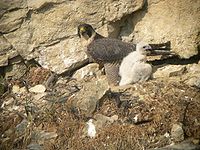
Falconiformes
The order Falconiformes is a group of about 290 species of birds that comprises the diurnal birds of prey. Raptor classification is difficult and the order is treated in several ways.- Classification problems :...
Family: Falconidae
Falconidae
The falcons and caracaras are around 60 species of diurnal birds of prey that make up the family Falconidae. The family is divided into two subfamiles, Polyborinae, which includes the caracaras and forest falcons, and Falconinae, the falcons, kestrels and falconets.-Description:Falcons and...
Falconidae is a family of diurnal birds of prey. They differ from hawks, eagles, and kites in that they kill with their beaks instead of their feet. There are 62 species worldwide and 8 species which occur in Gibraltar.
- Lesser KestrelLesser KestrelThe Lesser Kestrel is a small falcon. This species breeds from the Mediterranean across southern central Asia to China and Mongolia. It is a summer migrant, wintering in Africa and Pakistan and sometimes even to India and Iraq. It is rare north of its breeding range, and declining in its European...
Falco naumanni - Eurasian Kestrel Falco tinnunculus
- Red-footed FalconRed-footed FalconThe Red-footed Falcon , formerly Western Red-footed Falcon, is a bird of prey. It belongs to the family Falconidae, the falcons. This bird is found in eastern Europe and Asia although its numbers are dwindling rapidly due to habitat loss and hunting. It is migratory, wintering in Africa...
Falco vespertinus (A) - Eleonora's FalconEleonora's FalconEleonora's Falcon is a medium-sized falcon. It belongs to the hobby group, a rather close-knit number of similar falcons often considered a subgenus Hypotriorchis. The Sooty Falcon is sometimes considered its closest relative, but while they certainly belong to the same lineage, they do not seem...
Falco eleonorae - MerlinMerlin (bird)The Merlin is a small species of falcon from the Northern Hemisphere. A bird of prey once known colloquially as a pigeon hawk in North America, the Merlin breeds in the northern Holarctic; some migrate to subtropical and northern tropical regions in winter.-European and North American...
Falco columbarius - Eurasian HobbyEurasian HobbyThe Eurasian Hobby , or just simply Hobby, is a small slim falcon. It belongs to a rather close-knit group of similar falcons often considered a subgenus Hypotriorchis.-Description:...
Falco subbuteo - Lanner FalconLanner FalconThe Lanner Falcon is a large bird of prey that breeds in Africa, southeast Europe and just into Asia. It is mainly resident, but some birds disperse more widely after the breeding season.-Description:...
Falco biarmicus - Peregrine FalconPeregrine FalconThe Peregrine Falcon , also known as the Peregrine, and historically as the Duck Hawk in North America, is a widespread bird of prey in the family Falconidae. A large, crow-sized falcon, it has a blue-gray back, barred white underparts, and a black head and "moustache"...
Falco peregrinus
Pheasants and partridges
.jpg)
Galliformes
Galliformes are an order of heavy-bodied ground-feeding domestic or game bird, containing turkey, grouse, chicken, New and Old World Quail, ptarmigan, partridge, pheasant, and the Cracidae. Common names are gamefowl or gamebirds, landfowl, gallinaceous birds or galliforms...
Family: Phasianidae
Phasianidae
The Phasianidae is a family of birds which consists of the pheasants and partridges, including the junglefowl , Old World Quail, francolins, monals and peafowl. The family is a large one, and is occasionally broken up into two subfamilies, the Phasianinae, and the Perdicinae...
The Phasianidae are a family of terrestrial birds which consists of quail
Quail
Quail is a collective name for several genera of mid-sized birds generally considered in the order Galliformes. Old World quail are found in the family Phasianidae, while New World quail are found in the family Odontophoridae...
s, partridge
Partridge
Partridges are birds in the pheasant family, Phasianidae. They are a non-migratory Old World group.These are medium-sized birds, intermediate between the larger pheasants and the smaller quails. Partridges are native to Europe, Asia, Africa, and the Middle East...
s, snowcock
Snowcock
The snowcocks are a group of bird species in the genus Tetraogallus of the pheasant family, Phasianidae. They are ground-nesting birds which breed in the mountain ranges of southern Eurasia from the Caucasus to the Himalayas and western China. The Himalayan Snowcock has been introduced...
s, francolin
Francolin
Francolins are birds that traditionally have been placed in the genus Francolinus, but now commonly are divided into multiple genera , although some of the major taxonomic listing sources have yet to divide them. They are members of the pheasant family, Phasianidae...
s, spurfowls, tragopan
Tragopan
Tragopan is a genus of bird in the family Phasianidae. These birds are commonly called "horny pheasants" because of two brightly-colored, fleshy horns on their heads that they can erect during courtship displays...
s, monal
Monal
A Monal is a bird of genus Lophophorus of the Pheasant family, Phasianidae. There are three species and several sub-species within the genus Lophophorus:* Himalayan Monal Lophophorus impejanus* Sclater's Monal Lophophorus sclateri...
s, pheasant
Pheasant
Pheasants refer to some members of the Phasianinae subfamily of Phasianidae in the order Galliformes.Pheasants are characterised by strong sexual dimorphism, males being highly ornate with bright colours and adornments such as wattles and long tails. Males are usually larger than females and have...
s, peafowl
Peafowl
Peafowl are two Asiatic species of flying birds in the genus Pavo of the pheasant family, Phasianidae, best known for the male's extravagant eye-spotted tail, which it displays as part of courtship. The male is called a peacock, the female a peahen, and the offspring peachicks. The adult female...
s and jungle fowls. In general, they are plump (although they may vary in size) and have broad, relatively short wings. There are 156 species worldwide and 3 species which occur in Gibraltar.
- Barbary PartridgeBarbary PartridgeThe Barbary Partridge , is a gamebird in the pheasant family Phasianidae of the order Galliformes, gallinaceous birds....
Alectoris barbara - Common QuailCommon QuailThe Common Quail, Coturnix coturnix, is a small bird in the pheasant family Phasianidae. It is widespread and is found in parts of Europe, .- Description :It is a small rotund bird, essentially streaked brown with...
Coturnix coturnix - Common PheasantCommon PheasantThe Common Pheasant , is a bird in the pheasant family . It is native to Georgia and has been widely introduced elsewhere as a game bird. In parts of its range, namely in places where none of its relatives occur such as in Europe , it is simply known as the "pheasant"...
Phasianus colchicus (I, A)
Cranes
.jpg)
Gruiformes
The Gruiformes are an order containing a considerable number of living and extinct bird families, with a widespread geographical diversity. Gruiform means "crane-like"....
Family: Gruidae
Cranes are large, long-legged and long-necked birds. Unlike the similar-looking but unrelated herons, cranes fly with necks outstretched, not pulled back. Most have elaborate and noisy courting displays or "dances". There are 15 species worldwide and 1 species which occurs in Gibraltar.
- Common CraneCommon CraneThe Common Crane , also known as the Eurasian Crane, is a bird of the family Gruidae, the cranes.It is a large, stately bird and a medium-sized crane at 100–130 cm long, with a 180–240 cm wingspan and a weight of 4.5–6 kg...
Grus grus
Rails, crakes, gallinules, and coots
Order: GruiformesGruiformes
The Gruiformes are an order containing a considerable number of living and extinct bird families, with a widespread geographical diversity. Gruiform means "crane-like"....
Family: Rallidae
Rallidae
The rails, or Rallidae, are a large cosmopolitan family of small to medium-sized birds. The family exhibits considerable diversity and the family also includes the crakes, coots, and gallinules...
Rallidae is a large family of small to medium-sized birds which includes the rails, crakes, coot
Coot
Coots are medium-sized water birds that are members of the rail family Rallidae. They constitute the genus Fulica. Coots have predominantly black plumage, and, unlike many of the rails, they are usually easy to see, often swimming in open water...
s, and gallinule
Rallidae
The rails, or Rallidae, are a large cosmopolitan family of small to medium-sized birds. The family exhibits considerable diversity and the family also includes the crakes, coots, and gallinules...
s. Typically they inhabit dense vegetation in damp environments near lakes, swamps, or rivers. In general they are shy and secretive birds, difficult to observe. Most species have strong legs, and have long toes which are well adapted to soft, uneven surfaces. They tend to have short, rounded wings and be weak fliers. There are 143 species worldwide and 4 species which occur in Gibraltar.
- Purple SwamphenPurple SwamphenThe Purple Swamphen , also known as the African Purple Swamphen, Purple Moorhen, Purple Gallinule, Pūkeko or Purple Coot, is a large bird in the family Rallidae . From its name in French, talève sultane, it is also known as the Sultana Bird...
Porphyrio porphyrio (A) - Allen's GallinuleAllen's GallinuleThe Allen's Gallinule , formerly known as the Lesser Gallinule is a small waterbird of the family Rallidae. Its former binomial name is Porphyrula alleni....
Porphyrio alleni (A) - Common MoorhenCommon MoorhenThe Common Moorhen is a bird in the Rallidae family with an almost worldwide distribution. The North and South American Committees of the AOU and the IOC have voted on or before July 2011 to split the American forms into a new species Common Gallinule, however, no other committee has voted to...
Gallinula chloropus (A) - Eurasian CootEurasian CootThe Eurasian Coot, Fulica atra, also known as Coot, is a member of the rail and crake bird family, the Rallidae. The Australian subspecies is known as the Australian Coot.-Distribution:...
Fulica atra (A)
Bustards
Order: GruiformesGruiformes
The Gruiformes are an order containing a considerable number of living and extinct bird families, with a widespread geographical diversity. Gruiform means "crane-like"....
Family: Otididae
Bustards are large terrestrial birds mainly associated with dry open country and steppes in the Old World
Old World
The Old World consists of those parts of the world known to classical antiquity and the European Middle Ages. It is used in the context of, and contrast with, the "New World" ....
. They are omnivorous and nest on the ground. They walk steadily on strong legs and big toes, pecking for food as they go. They have long broad wings with "fingered" wingtips, and striking patterns in flight. Many have interesting mating displays. There are 26 species worldwide and 1 species which occurs in Gibraltar.
- Great BustardGreat BustardThe Great Bustard is in the bustard family, the only member of the genus Otis. It breeds in southern and central Europe, where it is the largest species of bird, and across temperate Asia...
Otis tarda (A)
Oystercatchers

Charadriiformes
Charadriiformes is a diverse order of small to medium-large birds. It includes about 350 species and has members in all parts of the world. Most Charadriiformes live near water and eat invertebrates or other small animals; however, some are pelagic , some occupy deserts and a few are found in thick...
Family: Haematopodidae
The oystercatcher
Oystercatcher
The oystercatchers are a group of waders; they form the family Haematopodidae, which has a single genus, Haematopus. They are found on coasts worldwide apart from the polar regions and some tropical regions of Africa and South East Asia...
s are large and noisy plover
Plover
Plovers are a widely distributed group of wading birds belonging to the subfamily Charadriinae. There are about 40 species in the subfamily, most of them called "plover" or "dotterel". The closely related lapwing subfamily, Vanellinae, comprises another 20-odd species.Plovers are found throughout...
-like birds, with strong bills used for smashing or prising open molluscs. There are 11 species worldwide and 1 species which occurs in Gibraltar.
- Eurasian OystercatcherEurasian OystercatcherThe Eurasian Oystercatcher Haematopus ostralegus, also known as the Common Pied Oystercatcher, or just Oystercatcher, is a wader in the oystercatcher bird family Haematopodidae. It is the most widespread of the oystercatchers, with three races breeding in western Europe, central Eurasia,...
Haematopus ostralegus
Avocets and stilts
Order: CharadriiformesCharadriiformes
Charadriiformes is a diverse order of small to medium-large birds. It includes about 350 species and has members in all parts of the world. Most Charadriiformes live near water and eat invertebrates or other small animals; however, some are pelagic , some occupy deserts and a few are found in thick...
Family: Recurvirostridae
Recurvirostridae
Recurvirostridae is a family of birds in the wader suborder Charadrii. It contains two distinct groups of birds, the avocets and the stilts .-Description and diet:...
Recurvirostridae is a family of large wading birds, which includes the avocet
Avocet
The four species of Avocets are a genus, Recurvirostra, of waders in the same avian family as the stilts.Avocets have long legs and long, thin, upcurved bills which they sweep from side to side when feeding in the brackish or saline wetlands they prefer...
s and the stilt
Stilt
Stilt is a common name for several species of birds in the family Recurvirostridae, which also includes those known as avocets. They are found in brackish or saline wetlands in warm or hot climates....
s. The avocets have long legs and long up-curved bills. The stilts have extremely long legs and long, thin, straight bills. There are 9 species worldwide and 2 species which occur in Gibraltar.
- Black-winged StiltBlack-winged StiltThe Black-winged Stilt or Common Stilt is a widely distributed very long-legged wader in the avocet and stilt family . Opinions differ as to whether the birds treated under the scientific name H. himantopus ought to be treated as a single species and if not, how many species to recognize...
Himantopus himantopus (A) - Pied AvocetPied AvocetThe Pied Avocet, Recurvirostra avosetta, is a large black and white wader in the avocet and stilt family, Recurvirostridae. They breed in temperate Europe and western and Central Asia. It is a migratory species and most winter in Africa or southern Asia...
Recurvirostra avosetta
Thick-knees

Charadriiformes
Charadriiformes is a diverse order of small to medium-large birds. It includes about 350 species and has members in all parts of the world. Most Charadriiformes live near water and eat invertebrates or other small animals; however, some are pelagic , some occupy deserts and a few are found in thick...
Family: Burhinidae
The thick-knees are a group of largely tropical waders in the family Burhinidae. They are found worldwide within the tropical zone, with some species also breeding in temperate Europe and Australia. They are medium to large waders with strong black or yellow black bills, large yellow eyes and cryptic plumage. Despite being classed as waders, most species have a preference for arid or semi-arid habitats. There are 9 species worldwide and 1 species which occurs in Gibraltar.
- Stone CurlewStone CurlewThe Stone Curlew, Eurasian Thick-knee, or Eurasian Stone-curlew Burhinus oedicnemus is a northern species of the Burhinidae bird family....
Burhinus oedicnemus
Pratincoles and coursers
Order: CharadriiformesCharadriiformes
Charadriiformes is a diverse order of small to medium-large birds. It includes about 350 species and has members in all parts of the world. Most Charadriiformes live near water and eat invertebrates or other small animals; however, some are pelagic , some occupy deserts and a few are found in thick...
Family: Glareolidae
Glareolidae
Glareolidae is a family of birds in the wader suborder Charadri. It contains two distinct groups, the pratincoles and the coursers. The coursers include the atypical Egyptian Plover, Pluvianus aegyptius, which has sometimes been placed in its own family...
Glareolidae is a family of wading birds comprising the pratincole
Pratincole
The Pratincoles or Greywaders are a group of birds which together with the coursers and Egyptian Plover make up the family Glareolidae. They have short legs, very long pointed wings and long forked tails....
s, which have short legs, long pointed wings and long forked tails, and the courser
Courser
The Coursers are a group of birds which together with the pratincoles make up the family Glareolidae. They have long legs, short wings and long pointed bills which curve downwards...
s, which have long legs, short wings and long pointed bills which curve downwards. There are 17 species worldwide and 1 species which occurs in Gibraltar.
- Collared PratincoleCollared PratincoleThe Collared Pratincole or Common Pratincole, Glareola pratincola, is a wader in the pratincole family, Glareolidae.Pratincoles are unusual among waders in that they typically hunt their insect prey on the wing like swallows, although they can also feed on the ground.The Collared Pratincole is a...
Glareola pratincola (A)
Plovers and lapwings
.jpg)
Charadriiformes
Charadriiformes is a diverse order of small to medium-large birds. It includes about 350 species and has members in all parts of the world. Most Charadriiformes live near water and eat invertebrates or other small animals; however, some are pelagic , some occupy deserts and a few are found in thick...
Family: Charadriidae
Charadriidae
The bird family Charadriidae includes the plovers, dotterels, and lapwings, about 64 to 66 species in all.- Morphology :They are small to medium-sized birds with compact bodies, short, thick necks and long, usually pointed, wings, but most species of lapwing may have more rounded wings...
The family Charadriidae includes the plover
Plover
Plovers are a widely distributed group of wading birds belonging to the subfamily Charadriinae. There are about 40 species in the subfamily, most of them called "plover" or "dotterel". The closely related lapwing subfamily, Vanellinae, comprises another 20-odd species.Plovers are found throughout...
s, dotterels, and lapwing
Lapwing
Vanellinae are any of various crested plovers, family Charadriidae, noted for its slow, irregular wingbeat in flight and a shrill, wailing cry. Its length is 10-16 inches. They are a subfamily of medium-sized wading birds which also includes the plovers and dotterels. The Vanellinae are...
s. They are small to medium-sized birds with compact bodies, short, thick necks and long, usually pointed, wings. They are found in open country worldwide, mostly in habitats near water, although there are some exceptions. There are 66 species worldwide and 5 species which occur in Gibraltar.
- Northern LapwingNorthern LapwingThe Northern Lapwing , also known as the Peewit, Green Plover or just Lapwing, is a bird in the plover family. It is common through temperate Eurasia....
Vanellus vanellus - Eurasian Golden-Plover Pluvialis apricaria (A)
- Grey PloverGrey PloverThe Grey Plover , known as the Black-bellied Plover in North America, is a medium-sized plover breeding in arctic regions. It is a long-distance migrant, with a nearly worldwide coastal distribution when not breeding....
Pluvialis squatarola (A) - Common Ringed Plover Charadrius hiaticula (A)
- Kentish PloverKentish PloverThe Kentish Plover, Charadrius alexandrinus, is a small wader in the plover bird family. Despite its name, this species no longer breeds in Kent, or even Great Britain...
Charadrius alexandrinus
Sandpipers and allies
.jpg)
Charadriiformes
Charadriiformes is a diverse order of small to medium-large birds. It includes about 350 species and has members in all parts of the world. Most Charadriiformes live near water and eat invertebrates or other small animals; however, some are pelagic , some occupy deserts and a few are found in thick...
Family: Scolopacidae
Scolopacidae
The sandpipers are a large family, Scolopacidae, of waders or shorebirds. They include many species called sandpipers, as well as those called by names such as curlew and snipe. The majority of these species eat small invertebrates picked out of the mud or soil...
The Scolopacidae are a large diverse family of small to medium sized shorebirds including the sandpipers, curlew
Curlew
The curlews , genus Numenius, are a group of eight species of birds, characterised by long, slender, downcurved bills and mottled brown plumage. They are one of the most ancient lineages of scolopacid waders, together with the godwits which look similar but have straight bills...
s, godwit
Godwit
The godwits are a group of large, long-billed, long-legged and strongly migratory wading birds of the genus Limosa. They form large flocks on coasts and estuaries in winter....
s, shanks
Tringa
Tringa is a genus of waders, containing the shanks and tattlers. They are mainly freshwater birds, often with brightly coloured legs as reflected in the English names of six species, as well as the specific names of two of these and the Green Sandpiper. They are typically associated with northern...
, tattler
Tattler (bird)
The tattlers are the two very similar bird species in the shorebird genus Tringa. They formerly had their own genus, Heteroscelus. The old genus name means "different leg" in Greek, referring to the leg scales that differentiate the tattlers from their close relatives, the shanks.The species are:*...
s, woodcock
Woodcock
The woodcocks are a group of seven or eight very similar living species of wading birds in the genus Scolopax. Only two woodcocks are widespread, the others being localized island endemics. Most are found in the Northern Hemisphere but a few range into Wallacea...
s, snipe
Snipe
A snipe is any of about 25 wading bird species in three genera in the family Scolopacidae. They are characterized by a very long, slender bill and crypsis plumage. The Gallinago snipes have a nearly worldwide distribution, the Lymnocryptes Jack Snipe is restricted to Asia and Europe and the...
s, dowitcher
Dowitcher
The three dowitchers are medium-sized long-billed wading birds. They resemble godwits in body and bill shape, and the reddish underparts in summer, but are much shorter legged, more like snipe to which they are also somewhat closer related...
s and phalarope
Phalarope
A phalarope or wadepiper is any of three living species of slender-necked shorebirds in the genus Phalaropus of the bird family Scolopacidae. They are close relatives of the shanks and tattlers, the Actitis and Terek Sandpipers, and also of the turnstones and calidrids...
s. The majority of species eat small invertebrates picked out of the mud or soil. Variation in length of legs and bills enable different species to feed in the same habitat, particularly on the coast, without direct competition for food. There are 89 species worldwide and 18 species which occur in Gibraltar.
- Eurasian WoodcockEurasian WoodcockThe Eurasian Woodcock, Scolopax rusticola, is a medium-small wading bird found in temperate and subarctic Eurasia. It has cryptic camouflage to suit its woodland habitat, with reddish-brown upperparts and buff-coloured underparts...
Scolopax rusticola (A) - Jack SnipeJack SnipeThe Jack Snipe, Lymnocryptes minimus is a small stocky wader. It is the smallest snipe, and the only member of the genus Lymnocryptes...
Lymnocryptes minimus (A) - Common SnipeCommon SnipeThe Common Snipe is a small, stocky wader native to the Old World. The breeding habitat is marshes, bogs, tundra and wet meadows throughout northern Europe and northern Asia...
Gallinago gallinago (A) - Black-tailed GodwitBlack-tailed GodwitThe Black-tailed Godwit, Limosa limosa, is a large, long-legged, long-billed shorebird first described by Carolus Linnaeus in 1758. It is a member of the Limosa genus, the godwits...
Limosa limosa (A) - Bar-tailed GodwitBar-tailed GodwitThe Bar-tailed Godwit is a large wader in the family Scolopacidae, which breeds on Arctic coasts and tundra mainly in the Old World, and winters on coasts in temperate and tropical regions of the Old World...
Limosa lapponica (A) - WhimbrelWhimbrelThe Whimbrel Numenius phaeopus, is a wader in the large family Scolopacidae. It is one of the mostwidespread of the curlews, breeding across much of subarctic North America, Europe and Asia as far south as Scotland....
Numenius phaeopus - Eurasian CurlewEurasian CurlewThe Eurasian Curlew, Numenius arquata, is a wader in the large family Scolopacidae. It is one of the most widespread of the curlews, breeding across temperate Europe and Asia...
Numenius arquata (A) - Common RedshankCommon RedshankThe Common Redshank or simply Redshank is an Eurasian wader in the large family Scolopacidae.- Description and systematics :...
Tringa totanus (A) - Green SandpiperGreen SandpiperThe Green Sandpiper is a small wader of the Old World. It represents an ancient lineage of the genus Tringa; its only close living relative is the Solitary Sandpiper . They both have brown wings with little light dots and a delicate but contrasting neck and chest pattern...
Tringa ochropus (A) - Common SandpiperCommon SandpiperThe Common Sandpiper is a small Palearctic wader. This bird and its American sister species, the Spotted Sandpiper , make up the genus Actitis. They are parapatric and replace each other geographically; stray birds of either species may settle down with breeders of the other and hybridize...
Actitis hypoleucos - Ruddy TurnstoneRuddy TurnstoneThe Ruddy Turnstone is a small wading bird, one of two species of turnstone in the genus Arenaria. It is now classified in the sandpiper family Scolopacidae but was formerly sometimes placed in the plover family Charadriidae...
Arenaria interpres - Red KnotRed KnotThe Red Knot, Calidris canutus , is a medium sized shorebird which breeds in tundra and the Arctic Cordillera in the far north of Canada, Europe, and Russia. It is a large member of the Calidris sandpipers, second only to the Great Knot...
Calidris canutus (A) - SanderlingSanderlingThe Sanderling is a small wader. It is a circumpolar Arctic breeder, and is a long-distance migrant, wintering south to South America, South Europe, Africa, and Australia...
Calidris alba (A) - Little StintLittle StintThe Little Stint, Calidris minuta , is a very small wader. It breeds in arctic Europe and Asia, and is a long-distance migrant, wintering south to Africa and south Asia...
Calidris minuta (A) - Curlew SandpiperCurlew SandpiperThe Curlew Sandpiper is a small wader that breeds on the tundra of Arctic Siberia. It is strongly migratory, wintering mainly in Africa, but also in south and southeast Asia and in Australasia...
Calidris ferruginea (A) - DunlinDunlinThe Dunlin, Calidris alpina, is a small wader, sometimes separated with the other "stints" in Erolia. It is a circumpolar breeder in Arctic or subarctic regions. Birds that breed in northern Europe and Asia are long-distance migrants, wintering south to Africa, southeast Asia and the Middle East...
Calidris alpina (A) - Red-necked PhalaropeRed-necked PhalaropeThe Red-necked Phalarope, Phalaropus lobatus, is a small wader. This phalarope breeds in the Arctic regions of North America and Eurasia. It is migratory, and, unusually for a wader, winters at sea on tropical oceans....
Phalaropus lobatus (A) - Grey Phalarope Phalaropus fulicarius
Skuas

Charadriiformes
Charadriiformes is a diverse order of small to medium-large birds. It includes about 350 species and has members in all parts of the world. Most Charadriiformes live near water and eat invertebrates or other small animals; however, some are pelagic , some occupy deserts and a few are found in thick...
Family: Stercorariidae
The family Stercorariidae are, in general, medium to large birds, typically with grey or brown plumage, often with white markings on the wings. They nest on the ground in temperate and arctic regions and are long-distance migrants. There are 7 species worldwide and 3 species which occur in Gibraltar.
- Great SkuaGreat SkuaThe Great Skua, Stercorarius skua, is a large seabird in the skua family Stercorariidae. In Britain, it is sometimes known by the name Bonxie, a Shetland name of unknown origin.-Description:...
Stercorarius skua - Pomarine SkuaPomarine SkuaThe Pomarine Skua, Stercorarius pomarinus, known as Pomarine Jaeger in North America, is a seabird in the skua family Stercorariidae. It is a migrant, wintering at sea in the tropical oceans.- Taxonomy :...
Stercorarius pomarinus - Arctic SkuaArctic SkuaThe Parasitic Jaeger, also known as the Arctic Skua or Parasitic Skua, is a seabird in the skua family Stercorariidae....
Stercorarius parasiticus
Gulls

Charadriiformes
Charadriiformes is a diverse order of small to medium-large birds. It includes about 350 species and has members in all parts of the world. Most Charadriiformes live near water and eat invertebrates or other small animals; however, some are pelagic , some occupy deserts and a few are found in thick...
Family: Laridae
Laridae is a family of medium to large birds seabirds and includes gull
Gull
Gulls are birds in the family Laridae. They are most closely related to the terns and only distantly related to auks, skimmers, and more distantly to the waders...
s and kittiwake
Kittiwake
The kittiwakes are two closely related seabird species in the gull family Laridae, the Black-legged Kittiwake and the Red-legged Kittiwake . The epithets "Black-legged" and "Red-legged" are used to distinguish the two species in North America, but in Europe, where R...
s. They are typically grey or white, often with black markings on the head or wings. They have stout, longish bills and webbed feet. There are 55 species worldwide and 16 species which occur in Gibraltar.
- Common GullCommon GullThe Common Gull or Mew Gull Larus canus is a medium-sized gull which breeds in northern Asia, northern Europe and northwestern North America. It migrates further south in winter...
Larus canus (A) - Audouin's GullAudouin's GullThe Audouin's Gull is a large gull restricted to the Mediterranean and the western coast of Saharan Africa. It breeds on small islands colonially or alone, laying 2-3 eggs on a ground nest...
Larus audouinii - Ring-billed GullRing-billed GullThe Ring-billed Gull is a medium-sized gull.Adults are length and with a wingspan. The head, neck and underparts are white; the relatively short bill is yellow with a dark ring; the back and wings are silver gray; and the legs are yellow. The eyes are yellow with red rims...
Larus delawarensis (A) - Great Black-backed GullGreat Black-backed GullThe Great Black-backed Gull is the largest gull in the world, which breeds on the European and North American coasts and islands of the North Atlantic...
Larus marinus (A) - Iceland GullIceland GullThe Iceland Gull, Larus glaucoides, is a large gull which breeds in the Arctic regions of Canada and Greenland, but not Iceland, where it is only seen in the winter. It is migratory, wintering from in the North Atlantic as far south as the British Isles and northernmost states of the eastern USA,...
Larus glaucoides (A) - Herring Gull Larus argentatus (A)
- Lesser Black-backed GullLesser Black-backed GullThe Lesser Black-backed Gull is a large gull that breeds on the Atlantic coasts of Europe. It is migratory, wintering from the British Isles south to West Africa...
Larus fuscus - Yellow-legged GullYellow-legged GullThe Yellow-legged Gull , sometimes referred to as Western Yellow-legged Gull , is a large gull of Europe, the Middle East and North Africa, which has only recently achieved wide recognition as a distinct species...
Larus michahellis - Grey-headed GullGrey-headed GullThe Grey-headed Gull is a small gull which breeds patchily in South America and Africa south of the Sahara. It is not truly migratory, but is more widespread in winter. This species has occurred as a rare vagrant to North America and Spain. It is also known as the Grey-hooded Gull...
Larus cirrocephalus (A) - Black-headed GullBlack-headed GullThe Black-headed Gull is a small gull which breeds in much of Europe and Asia, and also in coastal eastern Canada. Most of the population is migratory, wintering further south, but some birds in the milder westernmost areas of Europe are resident...
Larus ridibundus - Slender-billed GullSlender-billed GullThe Slender-billed Gull, Chroicocephalus genei, is a mid-sized gull which breeds very locally around the Mediterranean and the north of the western Indian Ocean on islands and coastal lagoons. Most of the population is somewhat migratory, wintering further south to north Africa and India, and a...
Larus genei (A) - Mediterranean GullMediterranean GullThe Mediterranean Gull, Ichthyaetus melanocephalus, is a small gull which breeds almost entirely in Europe, mainly in the south east, especially around the Black Sea, and in central Turkey. There are colonies elsewhere in southern Europe, and this species has undergone a dramatic range expansion in...
Larus melanocephalus - Laughing GullLaughing GullThe Laughing Gull, Leucophaeus atricilla, is a medium-sized gull of North and South America. It breeds on the Atlantic coast of North America, the Caribbean, and northern South America. Northernmost populations migrate further south in winter, and this species occurs as a rare vagrant to western...
Larus atricilla (A) - Little GullLittle GullThe Little Gull, Hydrocoloeus minutus or Larus minutus, is a small gull which breeds in northern Europe and Asia. It also has small colonies in parts of southern Canada. It is migratory, wintering on coasts in western Europe, the Mediterranean and the northeast USA. As is the case with many gulls,...
Larus minutus - Sabine's GullSabine's GullThe Sabine's Gull is a small gull. Its generic placement is disputed; some authors treat it as the sole species in the genus Xema as Xema sabini, while others retain it in the genus Larus as Larus sabini. It breeds in the arctic and has a circumpolar distribution through northernmost North America...
Xema sabini (A) - Black-legged KittiwakeBlack-legged KittiwakeThe Black-legged Kittiwake is a seabird species in the gull family Laridae.This species was first described by Linnaeus in his Systema naturae in 1758 as Larus tridactylus....
Rissa tridactyla
Terns
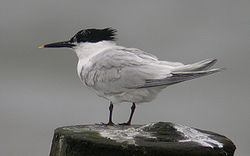
Charadriiformes
Charadriiformes is a diverse order of small to medium-large birds. It includes about 350 species and has members in all parts of the world. Most Charadriiformes live near water and eat invertebrates or other small animals; however, some are pelagic , some occupy deserts and a few are found in thick...
Family: Sternidae
Tern
Tern
Terns are seabirds in the family Sternidae, previously considered a subfamily of the gull family Laridae . They form a lineage with the gulls and skimmers which in turn is related to skuas and auks...
s are a group of generally general medium to large sea-birds typically with grey or white plumage, often with black markings on the head. Most terns hunt fish by diving but some pick insects off the surface of fresh water. Terns are generally long-lived birds, with several species now known to live in excess of 25 to 30 years. There are 44 species worldwide and 12 species which occur in Gibraltar.
- Gull-billed TernGull-billed TernThe Gull-billed Tern formerly Sterna nilotica , is a seabird of the tern family Sternidae...
Sterna nilotica - Caspian TernCaspian TernThe Caspian Tern is a species of tern, with a subcosmopolitan but scattered distribution. Despite its extensive range, it is monotypic of its genus, and has no subspecies accepted either...
Sterna caspia - Lesser Crested TernLesser Crested TernThe Lesser Crested Tern is a seabird of the tern family Sternidae...
Sterna bengalensis - Sandwich Tern Sterna sandvicensis
- Royal TernRoyal TernThe Royal Tern is a seabird in the tern family Sternidae. This bird has two distinctive subspecies. T. m. maximus breeds on the Atlantic and Pacific coasts of the southern USA and Mexico into the Caribbean. The slightly smaller T. m. albididorsalis breeds in coastal west Africa...
Sterna maxima (A) - Roseate TernRoseate TernThe Roseate Tern is a seabird of the tern family Sternidae. This bird has a number of geographical races, differing mainly in bill colour and minor plumage details....
Sterna dougallii (A) - Common TernCommon TernThe Common Tern is a seabird of the tern family Sternidae. This bird has a circumpolar distribution, breeding in temperate and sub-Arctic regions of Europe, Asia and east and central North America. It is strongly migratory, wintering in coastal tropical and subtropical regions. It is sometimes...
Sterna hirundo - Arctic TernArctic TernThe Arctic Tern is a seabird of the tern family Sternidae. This bird has a circumpolar breeding distribution covering the Arctic and sub-Arctic regions of Europe, Asia, and North America...
Sterna paradisaea (A) - Little TernLittle TernThe Little Tern, Sternula albifrons or Sterna albifrons, is a seabird of the tern family Sternidae. It was formerly placed into the genus Sterna, which now is restricted to the large white terns . The former North American and Red Sea S. a...
Sterna albifrons - Whiskered TernWhiskered TernThe Whiskered Tern is a seabird of the tern family Sternidae. This bird has a number of geographical races, differing mainly in size and minor plumage details....
Chlidonias hybridus (A) - White-winged TernWhite-winged TernThe White-winged Tern, or White-winged Black Tern, Chlidonias leucopterus, is a small tern generally found in or near bodies of fresh water across from Southeastern Europe east to Australia....
Chlidonias leucopterus (A) - Black TernBlack TernThe Black Tern, Chlidonias niger, is a small tern generally found in or near inland water in Europe and North America. As its name suggests, it has predominantly dark plumage.- Description :...
Chlidonias niger
Auks
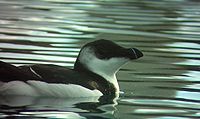
Charadriiformes
Charadriiformes is a diverse order of small to medium-large birds. It includes about 350 species and has members in all parts of the world. Most Charadriiformes live near water and eat invertebrates or other small animals; however, some are pelagic , some occupy deserts and a few are found in thick...
Family: Alcidae
Alcids are superficially similar to penguins due to their black-and-white colours, their upright posture and some of their habits, however they are not related to the penguins bnd differ in being able to fly. Auks live on the open sea, only deliberately coming ashore to nest. There are 24 species worldwide and 3 species which occur in Gibraltar.
- Common GuillemotCommon GuillemotThe Common Murre or Common Guillemot is a large auk. It is also known as the Thin-billed Murre in North America. It has a circumpolar distribution, occurring in low-Arctic and boreal waters in the North-Atlantic and North Pacific...
Uria aalge - RazorbillRazorbillThe Razorbill is colonial seabird that will only come to land in order to breed. It is the largest living member of the Auk family. This agile bird will choose only one partner for life and females will lay one egg per year. Razorbills will nest along coastal cliffs in enclosed or slightly exposed...
Alca torda - Atlantic PuffinAtlantic PuffinThe Atlantic Puffin is a seabird species in the auk family. It is a pelagic bird that feeds primarily by diving for fish, but also eats other sea creatures, such as squid and crustaceans. Its most obvious characteristic during the breeding season is its brightly coloured bill...
Fratercula arctica
Sandgrouse
Order: PterocliformesFamily: Pteroclidae
Sandgrouse have small, pigeon like heads and necks, but sturdy compact bodies. They have long pointed wings and sometimes tails and a fast direct flight. Flocks fly to watering holes at dawn and dusk. Their legs are feathered down to the toes. There are 16 species worldwide and 1 species which occurs in Gibraltar.
- Pin-tailed SandgrousePin-tailed SandgrouseThe Pin-tailed Sandgrouse is a medium large bird in the sandgrouse family.The nominate race breeds in Iberia and southern France, and the eastern form P. a. caudacutus is found in northwest Africa, and from southeast Turkey east to Kazakhstan...
Pterocles alchata (A)
Pigeons and doves

Columbiformes
Columbiformes are an avian order that includes the very widespread and successful doves and pigeons, classified in the family Columbidae, and the extinct Dodo and the Rodrigues Solitaire, long classified as a second family Raphidae. 313 species, found worldwide, comprise the Columbiformes order....
Family: Columbidae
Pigeons and dove
Dove
Pigeons and doves constitute the bird family Columbidae within the order Columbiformes, which include some 300 species of near passerines. In general terms "dove" and "pigeon" are used somewhat interchangeably...
s are stout-bodied birds with short necks and short slender bills with a fleshy cere
Cère
The Cère is a long river in south-western France, left tributary of the Dordogne River. Its source is in the south-western Massif Central, near the mountain Plomb du Cantal...
. There are 308 species worldwide and 5 species which occur in Gibraltar.
- Rock PigeonRock PigeonThe Rock Dove or Rock Pigeon, is a member of the bird family Columbidae . In common usage, this bird is often simply referred to as the "pigeon"....
Columba livia - Stock PigeonStock PigeonThe Stock Dove or Stock Pigeon is a species of bird in the Columba genus in the Columbidae family. It is a member of the family Columbidae, doves and pigeons.-Description:...
Columba oenas (A) - Common Wood-Pigeon Columba palumbus (A)
- Eurasian Turtle-Dove Streptopelia turtur
- Eurasian Collared-Dove Streptopelia decaocto
Cuckoos
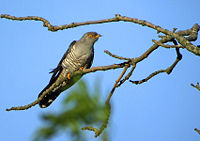
Cuculiformes
The near passerine bird order Cuculiformes traditionally included three families as below:* Musophagidae - turacos and allies* Cuculidae - cuckoos, coucals, roadrunners and anis* Opisthocomidae - Hoatzin...
Family: Cuculidae
The family Cuculidae includes cuckoo
Cuckoo
The cuckoos are a family, Cuculidae, of near passerine birds. The order Cuculiformes, in addition to the cuckoos, also includes the turacos . Some zoologists and taxonomists have also included the unique Hoatzin in the Cuculiformes, but its taxonomy remains in dispute...
s, roadrunner
Geococcyx
The roadrunners are two species of bird in the genus Geococcyx of the cuckoo family, Cuculidae, native to North and Central America...
s and anis
Ani (bird)
The anis are the three species of near-passerine birds in the genus Crotophaga of the cuckoo family. They are essentially tropical New world birds, although the range of two species just reaches the United States...
. These birds are of variable size with slender bodies, long tails and strong legs. Unlike the cuckoo species of the Old World, North American cuckoos are not brood parasites. There are 138 species worldwide and 2 species which occur in Gibraltar.
- Great Spotted CuckooGreat Spotted CuckooThe Great Spotted Cuckoo is a member of the cuckoo order of birds, the Cuculiformes, which also includes the roadrunners, the anis and the coucals....
Clamator glandarius - Common CuckooCommon CuckooThe Common Cuckoo is a member of the cuckoo order of birds, Cuculiformes, which includes the roadrunners, the anis and the coucals....
Cuculus canorus
Barn owls
Order: StrigiformesFamily: Tytonidae
Tytonidae
Barn-owls are one of the two families of owls, the other being the true owls, Strigidae. They are medium to large sized owls with large heads and characteristic heart-shaped faces. They have long, strong legs with powerful talons...
Barn owl
Barn Owl
The Barn Owl is the most widely distributed species of owl, and one of the most widespread of all birds. It is also referred to as Common Barn Owl, to distinguish it from other species in the barn-owl family Tytonidae. These form one of two main lineages of living owls, the other being the typical...
s are medium to large sized owls with large heads and characteristic heart-shaped faces. They have long strong legs with powerful talons. There are 16 species worldwide and 1 species which occurs in Gibraltar.
- Barn OwlBarn OwlThe Barn Owl is the most widely distributed species of owl, and one of the most widespread of all birds. It is also referred to as Common Barn Owl, to distinguish it from other species in the barn-owl family Tytonidae. These form one of two main lineages of living owls, the other being the typical...
Tyto alba
Typical owls
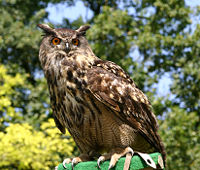
Family: Strigidae
Typical owl
Typical owl
True owl or Typical owl are one of the two generally accepted families of Owls, the other being the barn owls . The Sibley-Ahlquist taxonomy unites the Caprimulgiformes with the owl order; here, the typical owls are a subfamily Strigidae...
s are small to large solitary nocturnal birds of prey. They have large forward-facing eyes and ears, a hawk-like beak, and a conspicuous circle of feathers around each eye called a facial disk. There are 195 species worldwide and 6 species which occur in Gibraltar.
- European Scops-Owl Otus scops
- Eurasian Eagle-Owl Bubo bubo
- Tawny OwlTawny OwlThe Tawny Owl or Brown Owl is a stocky, medium-sized owl commonly found in woodlands across much of Eurasia. Its underparts are pale with dark streaks, and the upperparts are either brown or grey. Several of the eleven recognised subspecies have both variants...
Strix aluco - Little OwlLittle OwlThe Little Owl is a bird which is resident in much of the temperate and warmer parts of Europe, Asia east to Korea, and north Africa. It is not native to Great Britain, but was first introduced in 1842, and is now naturalised there...
Athene noctua - Long-eared OwlLong-eared OwlThe Long-eared Owl - Asio otus is a species of owl which breeds in Europe, Asia, and North America. This species is a part of the larger grouping of owls known as typical owls, family Strigidae, which contains most species of owl...
Asio otus (A) - Short-eared OwlShort-eared OwlThe Short-eared Owl is a species of typical owl . In Scotland this species of owl is often referred to as a cataface, grass owl or short-horned hootlet. Owls belonging to genus Asio are known as the eared owls, as they have tufts of feathers resembling mammalian ears. These "ear" tufts may or may...
Asio flammeus (A)
Nightjars
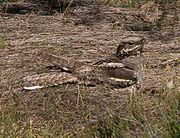
Caprimulgiformes
The Caprimulgiformes is an order of birds that includes a number of birds with global distribution . They are generally insectivorous and nocturnal...
Family: Caprimulgidae
Nightjar
Nightjar
Nightjars are medium-sized nocturnal or crepuscular birds with long wings, short legs and very short bills. They are sometimes referred to as goatsuckers from the mistaken belief that they suck milk from goats . Some New World species are named as nighthawks...
s are medium-sized nocturnal birds with long wings, short legs and very short bills that usually nest on the ground. Most have small feet, of little use for walking, and long pointed wings. Their soft plumage is camouflaged to resemble bark or leaves. There are 86 species worldwide and 2 species which occur in Gibraltar.
- Red-necked NightjarRed-necked NightjarThe Red-necked Nightjar, Caprimulgus ruficollis, is the largest of the nightjars occurring in Europe. It breeds in Iberia and north Africa, and winters in tropical west Africa.-Habitat:...
Caprimulgus ruficollis - Eurasian Nightjar Caprimulgus europaeus
Swifts
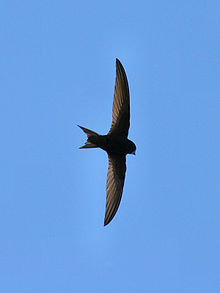
Apodiformes
Traditionally, the bird order Apodiformes contained three living families: the swifts , the tree swifts , and the hummingbirds . In the Sibley-Ahlquist taxonomy, this order is raised to a superorder Apodimorphae in which hummingbirds are separated as a new order, Trochiliformes...
Family: Apodidae
Swift
Swift
The swifts are a family, Apodidae, of highly aerial birds. They are superficially similar to swallows, but are actually not closely related to passerine species at all; swifts are in the separate order Apodiformes, which they share with hummingbirds...
s are small aerial birds, spending the majority of their lives flying. These birds have very short legs and never settle voluntarily on the ground, perching instead only on vertical surfaces. Many swifts have long swept-back wings that resemble a crescent or a boomerang. There are 98 species worldwide and 5 species which occur in Gibraltar.
- Alpine SwiftAlpine SwiftThe Alpine Swift syn. is a species of Swift. The bird is superficially similar to a large Barn Swallow or House Martin. It is, however, completely unrelated to those passerine species, since swifts are in the order Apodiformes...
Tachymarptis melba - Common SwiftCommon SwiftThe Common Swift is a small bird, superficially similar to the Barn Swallow or House Martin. It is, however, completely unrelated to those passerine species, since swifts are in the separate order Apodiformes...
Apus apus - Pallid SwiftPallid SwiftThe Pallid Swift is a small bird, superficially similar to a Barn Swallow or House Martin. It is, however, completely unrelated to those passerine species, since the swifts are in the order Apodiformes...
Apus pallidus - Little SwiftLittle SwiftThe Little Swift , is a small bird, superficially similar to a Barn Swallow or House Martin. It is, however, completely unrelated to those passerine species, since swifts are in the order Apodiformes. The resemblances between the groups are due to convergent evolution reflecting similar life styles...
Apus affinis (A) - White-rumped SwiftWhite-rumped SwiftThe White-rumped Swift is a small swift. Although this bird is superficially similar to a House Martin, it is completely unrelated to that passerine species. The resemblances between the swallows and swifts are due to convergent evolution reflecting similar life styles.Swifts have very short legs...
Apus caffer (A)
Kingfishers
Order: CoraciiformesCoraciiformes
The Coraciiformes are a group of usually colorful near passerine birds including the kingfishers, the Hoopoe, the bee-eaters, the rollers, and the hornbills...
Family: Alcedinidae
Kingfishers are medium-sized birds with large heads, long pointed bills, short legs, and stubby tails. There are 93 species worldwide and 1 species which occurs in Gibraltar.
- Common Kingfisher Alcedo atthis
Bee-eaters

Coraciiformes
The Coraciiformes are a group of usually colorful near passerine birds including the kingfishers, the Hoopoe, the bee-eaters, the rollers, and the hornbills...
Family: Meropidae
The bee-eaters are a group of near passerine
Near passerine
Near passerine or higher land-bird assemblage are terms often given to arboreal birds or those most often believed to be related to the true passerines due to ecological similarities; the group corresponds to some extent with the Anomalogonatae of Garrod All near passerines are land birds...
birds in the family Meropidae. Most species are found in Africa but others occur in southern Europe, Madagascar, Australia and New Guinea. They are characterised by richly coloured plumage, slender bodies and usually elongated central tail feathers. All are colorful and have long downturned bills and pointed wings, which give them a swallow-like appearance when seen from afar. There are 26 species worldwide and 2 species which occur in Gibraltar.
- Blue-cheeked Bee-eaterBlue-cheeked Bee-eaterThe Blue-cheeked Bee-eater, Merops persicus, is a near passerine bird in the bee-eater family, Meropidae. It breeds in Northern Africa, and the Middle East from eastern Turkey to Kazakhstan and India. It is generally strongly migratory, wintering in tropical Africa, although some populations breed...
Merops persicus (A) - European Bee-eaterEuropean Bee-eaterThe European Bee-eater, Merops apiaster, is a near passerine bird in the bee-eater family Meropidae. It breeds in southern Europe and in parts of north Africa and western Asia. It is strongly migratory, wintering in tropical Africa, India and Sri Lanka...
Merops apiaster
Rollers
Order: CoraciiformesCoraciiformes
The Coraciiformes are a group of usually colorful near passerine birds including the kingfishers, the Hoopoe, the bee-eaters, the rollers, and the hornbills...
Family: Coraciidae
Rollers resemble crow
Crow
Crows form the genus Corvus in the family Corvidae. Ranging in size from the relatively small pigeon-size jackdaws to the Common Raven of the Holarctic region and Thick-billed Raven of the highlands of Ethiopia, the 40 or so members of this genus occur on all temperate continents and several...
s in size and build, but are more closely related to the kingfisher
Kingfisher
Kingfishers are a group of small to medium sized brightly coloured birds in the order Coraciiformes. They have a cosmopolitan distribution, with most species being found in the Old World and Australia...
s and bee-eater
Bee-eater
The bee-eaters are a group of near-passerine birds in the family Meropidae. Most species are found in Africa and Asia but others occur in southern Europe, Australia, and New Guinea. They are characterised by richly coloured plumage, slender bodies, and usually elongated central tail feathers...
s. They share the colourful appearance of those groups with blues and browns predominating. The two inner front toes are connected, but the outer toe is not. There are 12 species worldwide and 1 species which occurs in Gibraltar.
- European RollerEuropean RollerThe European Roller, Coracias garrulus, is the only member of the roller family of birds to breed in Europe. Its overall range extends into the Middle East and Central Asia and Morocco....
Coracias garrulus
Hoopoes
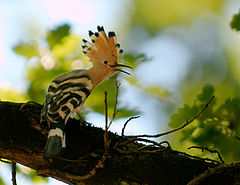
Coraciiformes
The Coraciiformes are a group of usually colorful near passerine birds including the kingfishers, the Hoopoe, the bee-eaters, the rollers, and the hornbills...
Family: Upupidae
Hoopoes have black, white and orangey-pink colouring with a large erectile crest on their head. There are 2 species worldwide and 1 species which occurs in Gibraltar.
- HoopoeHoopoeThe Hoopoe is a colourful bird that is found across Afro-Eurasia, notable for its distinctive 'crown' of feathers. It is the only extant species in the family Upupidae. One insular species, the Giant Hoopoe of Saint Helena, is extinct, and the Madagascar subspecies of the Hoopoe is sometimes...
Upupa epops
Woodpeckers and allies
Order: PiciformesPiciformes
Nine families of largely arboreal birds make up the order Piciformes, the best-known of them being the Picidae, which includes the woodpeckers and close relatives...
Family: Picidae
Picidae
The woodpeckers, piculets and wrynecks are a family, Picidae, of near-passerine birds. Members of this family are found worldwide, except for Australia and New Zealand, Madagascar, and the extreme polar regions...
Woodpeckers are small to medium sized birds with chisel like beaks, short legs, stiff tails and long tongues used for capturing insects. Some species have feet with two toes pointing forward, and two backward, while several species have only three toes. Many woodpeckers have the habit of tapping noisily on tree trunks with their beaks. There are 218 species worldwide and 3 species which occur in Gibraltar.
- Eurasian WryneckEurasian WryneckThe Eurasian Wryneck, Jynx torquilla, is a species of wryneck in the family of woodpeckers.This species breeds in temperate regions of Europe and Asia. It is migratory, wintering in tropical Africa and southern Asia. It is a bird of open woodland and orchards...
Jynx torquilla - Great Spotted WoodpeckerGreat Spotted WoodpeckerThe Great Spotted Woodpecker , Dendrocopos major, is a bird species of the woodpecker family . It is distributed throughout Europe and northern Asia, and usually resident year-round except in the colder parts of its range...
Dendrocopos major (A) - European Green Woodpecker Picus viridis (A)
Larks

Family: Alaudidae
Larks are small terrestrial birds with often extravagant songs and display flights. Most larks are fairly dull in appearance. Their food is insects and seeds. There are 91 species worldwide and 7 species which occur in Gibraltar.
- Calandra LarkCalandra LarkThe Calandra Lark, Melanocorypha calandra, breeds in warm temperate countries around the Mediterranean and eastwards through Turkey into northern Iran and southern Russia...
Melanocorypha calandra (A) - Greater Short-toed LarkGreater Short-toed LarkThe Greater Short-toed Lark or sometimes just Short-toed Lark is a small passerine bird. It breeds in southern Europe, northwest Africa, and across temperate Asia from Turkey and southern Russia to Mongolia. It is sometimes considered conspecific with Calandrella cinerea...
Calandrella brachydactyla - Lesser Short-toed LarkLesser Short-toed LarkThe Lesser Short-toed Lark is a small passerine bird. It breeds in Spain, north Africa, also including Turkey eastwards across the semi-deserts of central Asia to Mongolia and China....
Calandrella rufescens (A) - Crested LarkCrested LarkThe Crested Lark, Galerida cristata, breeds across most of temperate Eurasia from Portugal to northeast China and eastern India, and in Africa south to Niger...
Galerida cristata - Thekla LarkThekla LarkThe Thekla Lark, Galerida theklae, breeds in Iberia, northern Africa, and sub-Saharan Africa from Senegal to Somalia. It is a sedentary species....
Galerida theklae - Wood Lark Lullula arborea
- Eurasian Skylark Alauda arvensis
Swallows and martins
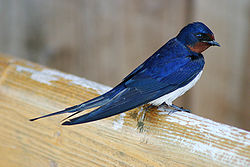
Family: Hirundinidae
The Hirundinidae family is a group of passerines characterized by their adaptation to aerial feeding. Their adaptations include a slender streamlined body, long pointed wings and short bills with wide gape. The feet are designed for perching rather than walking, and the front toes are partially joined at the base. There are 75 species worldwide and 5 species which occur in Gibraltar.
- Bank Swallow Riparia riparia
- Eurasian Crag-Martin Ptyonoprogne rupestris
- Barn SwallowBarn SwallowThe Barn Swallow is the most widespread species of swallow in the world. It is a distinctive passerine bird with blue upperparts, a long, deeply forked tail and curved, pointed wings. It is found in Europe, Asia, Africa and the Americas...
Hirundo rustica - Red-rumped SwallowRed-rumped SwallowThe Red-rumped Swallow is a small passerine bird in the swallow family. It breeds in open hilly country of temperate southern Europe and Asia from Portugal and Spain to Japan, India and tropical Africa. The Indian and African birds are resident, but European and other Asian birds are migratory...
Cecropis daurica - Common House-Martin Delichon urbica
Wagtails and pipits

Family: Motacillidae
Motacillidae
The Motacillidae are a family of small passerine birds with medium to long tails. There are around 65 species in 6 genera and they include the wagtails, longclaws and pipits. The longclaws are entirely restricted to the Afrotropics, and the wagtails are predominately found in Europe, Africa and...
The Motacillidae are a family of small passerine birds with medium to long tails. They include the wagtails, longclaws and pipits. They are slender, ground feeding insectivores of open country. There are 54 species worldwide and 10 species which occur in Gibraltar.
- White WagtailWhite Wagtail"Pied Wagtail" redirects here. For the related African bird, see African Pied Wagtail.The White Wagtail is a small passerine bird in the wagtail family Motacillidae, which also includes the pipits and longclaws. This species breeds in much of Europe and Asia and parts of north Africa...
Motacilla alba - Yellow Wagtail Motacilla flava
- Grey WagtailGrey WagtailThe Grey Wagtail is a small member of the wagtail family, Motacillidae. The species looks similar to the Yellow Wagtail but has the yellow on its underside restricted to the throat and vent. Breeding males have a black throat...
Motacilla cinerea - Richard's PipitRichard's PipitThe Richard's Pipit is a medium-sized passerine bird which breeds in open grasslands in northern Asia. It is a long-distance migrant moving to open lowlands in southern Asia. It is a rare but regular vagrant to western Europe...
Anthus richardi (A) - Tawny PipitTawny PipitThe Tawny Pipit, Anthus campestris, is a medium-large passerine bird which breeds in much of temperate Europe and Asia, and northwest Africa. It is a migrant moving in winter to tropical Africa and the Indian subcontinent....
Anthus campestris - Tree PipitTree PipitTree Pipit, Anthus trivialis, is a small passerine bird which breeds across most of Europe and temperate western and central Asia. It is a long-distance migrant moving in winter to Africa and southern Asia....
Anthus trivialis - Meadow PipitMeadow PipitThe Meadow Pipit Anthus pratensis, is a small passerine bird which breeds in much of the northern half of Europe and also northwestern Asia, from southeastern Greenland and Iceland east to just east of the Ural Mountains in Russia, and south to central France and Romania; there is also an isolated...
Anthus pratensis - Red-throated PipitRed-throated PipitThe Red-throated Pipit is a small passerine bird which breeds in the far north of Europe and Asia, with a foothold in northern Alaska. It is a long-distance migrant moving in winter to Africa, south and east Asia and west coast USA...
Anthus cervinus (A) - Rock PipitRock PipitThe Rock Pipit, Anthus petrosus, is a small passerine bird species which breeds on rocky coasts of western Europe northwards from Brittany. It is mainly resident in Ireland, Great Britain and France, in the west of its range, but the Scandinavian and Russian populations migrate south in winter;...
Anthus petrosus (A) - Water PipitWater PipitThe Water Pipit, Anthus spinoletta, is a small passerine bird which breeds in the mountains of southern Europe and southern temperate Asia across to China. It is a short-distance migrant moving to wet open lowlands such as marshes and flooded fields in winter...
Anthus spinoletta (A)
Kinglets
Order: PasseriformesFamily: Regulidae
The kinglets or crests are a small group of birds often included in the Old World warblers, but frequently given family status because they also resemble the titmice
Titmouse
The tits, chickadees, and titmice constitute Paridae, a large family of small passerine birds which occur in the northern hemisphere and Africa...
. There are 7 species worldwide and 2 species which occur in Gibraltar.
- GoldcrestGoldcrestThe Goldcrest, Regulus regulus, is a very small passerine bird in the kinglet family. Its colourful golden crest feathers gives rise to its English and scientific names, and possibly to it being called the "king of the birds" in European folklore. Several subspecies are recognised across the very...
Regulus regulus - Common Firecrest Regulus ignicapillus
Wrens
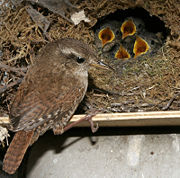
Family: Troglodytidae
The wren
Wren
The wrens are passerine birds in the mainly New World family Troglodytidae. There are approximately 80 species of true wrens in approximately 20 genera....
s are mainly small and inconspicuous except for their loud songs. These birds have short wings and a thin down-turned bill. Several species often hold their tails upright. All are insectivorous. There are 80 species worldwide (of which all but one are New World species) and 1 species which occurs in Gibraltar.
- Winter WrenWinter WrenThe Winter Wren is a very small North American bird and a member of the mainly New World wren family Troglodytidae. It was once lumped with Troglodytes pacificus of western North America and Troglodytes troglodytes of Eurasia under the name Winter Wren.It breeds in coniferous forests from British...
Troglodytes troglodytes
Accentors
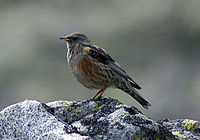
Family: Prunellidae
The accentors are in the only bird family, Prunellidae, which is completely endemic to the Palearctic
Palearctic
The Palearctic or Palaearctic is one of the eight ecozones dividing the Earth's surface.Physically, the Palearctic is the largest ecozone...
. They are small, fairly drab species superficially similar to sparrow
Sparrow
The sparrows are a family of small passerine birds, Passeridae. They are also known as true sparrows, or Old World sparrows, names also used for a genus of the family, Passer...
s. There are 13 species worldwide and 2 species which occur in Gibraltar.
- Alpine AccentorAlpine AccentorThe Alpine Accentor, Prunella collaris, is a small passerine bird found throughout the mountains of southern temperate Europe and Asia at heights above 2000 m. It is mainly resident, wintering more widely at lower latitudes, but some birds wander as rare vagrants as far as Great Britain.It is...
Prunella collaris - DunnockDunnockThe Dunnock, Prunella modularis, is a small passerine bird found throughout temperate Europe and into Asia. It is by far the most widespread member of the accentor family, which otherwise consists of mountain species...
Prunella modularis
Thrushes and allies
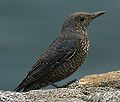
Family: Turdidae
The thrushes
Thrush (bird)
The thrushes, family Turdidae, are a group of passerine birds that occur worldwide.-Characteristics:Thrushes are plump, soft-plumaged, small to medium-sized birds, inhabiting wooded areas, and often feed on the ground or eat small fruit. The smallest thrush may be the Forest Rock-thrush, at and...
are a group of passerine birds that occur mainly in the Old World. They are plump, soft plumaged, small to medium-sized insectivores or sometimes omnivores, often feeding on the ground. Many have attractive songs. There are 176 species worldwide and 8 species which occur in Gibraltar.
- Rufous-tailed Rock-Thrush Monticola saxatilis
- Blue Rock-Thrush Monticola solitarius
- Ring OuzelRing OuzelThe Ring Ouzel is a European member of the thrush family Turdidae.It is the mountain equivalent of the closely related Common Blackbird, and breeds in gullies, rocky areas or scree slopes....
Turdus torquatus - Eurasian Blackbird Turdus merula
- FieldfareFieldfareThe Fieldfare is a member of the thrush family Turdidae. It breeds in woodland and scrub in northern Europe and Asia. It is strongly migratory, with many northern birds moving south during the winter. It is a very rare breeder in Great Britain and Ireland, but winters in large numbers in these...
Turdus pilaris - RedwingRedwingThe Redwing is a bird in the thrush family Turdidae, native to Europe and Asia, slightly smaller than the related Song Thrush.-Taxonomy:...
Turdus iliacus - Song ThrushSong ThrushThe Song Thrush is a thrush that breeds across much of Eurasia. It is also known in English dialects as throstle or mavis. It has brown upperparts and black-spotted cream or buff underparts and has three recognised subspecies...
Turdus philomelos - Mistle ThrushMistle ThrushThe Mistle Thrush is a member of the thrush family Turdidae.It is found in open woods and cultivated land over all of Europe and much of Asia...
Turdus viscivorus (A)
Cisticolas and allies
_i_img_0365.jpg)
Family: Cisticolidae
Cisticolidae
The Cisticolidae family of small passerine birds is a group of about 110 warblers found mainly in warmer southern regions of the Old World. They are often included within the Old World warbler family Sylviidae....
The Cisticolidae are warblers found mainly in warmer southern regions of the Old World. They are generally very small birds of drab brown or grey appearance found in open country such as grassland or scrub. There are 111 species worldwide and 1 species which occur in Gibraltar.
- Zitting CisticolaZitting CisticolaThe Zitting Cisticola or Streaked Fantail Warbler , is widely distributed Old World warbler whose breeding range includes southern Europe, Africa outside the deserts and rainforest, and southern Asia down to northern Australia...
Cisticola juncidis
Old World warblers
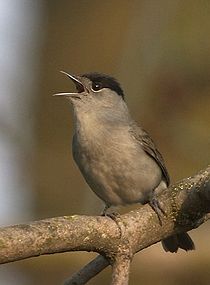
Family: Sylviidae
Sylviidae
Sylviidae is a family of passerine birds that was part of an assemblage known as the Old World warblers. The family was formerly a wastebin taxon with over 400 species of bird in over 70 genera. The family was poorly defined with many characteristics shared with other families...
The family Sylviidae is a group of small insectivorous passerine birds. The Sylviidae mainly occur as breeding species, as the common name implies, in Europe, Asia and, to a lesser extent Africa. Most are of generally undistinguished appearance, but many have distinctive songs. There are 291 species worldwide and 31 species which occur in Gibraltar.
- Cetti's WarblerCetti's WarblerCetti's Warbler , Cettia cetti, is an Old World warbler which breeds in Europe, northwest Africa and east southern temperate Asia as far as Afghanistan and NW Pakistan. It is the only bush warbler to occur outside Asia...
Cettia cetti (A) - Grasshopper WarblerGrasshopper WarblerThe Grasshopper Warbler, Locustella naevia, is an Old World warbler in the grass warbler genus Locustella. It breeds across much of temperate Europe and Asia. It is migratory, wintering from northwest Africa to India....
Locustella naevia - Savi's WarblerSavi's WarblerThe Savi's Warbler, Locustella luscinioides, is an Old World warbler in the grass warbler genus Locustella. It breeds in southern Europe into temperate western Asia. It is migratory, wintering in sub-Saharan Africa....
Locustella luscinioides (A) - Moustached WarblerMoustached WarblerThe Moustached Warbler, Acrocephalus melanopogon, is an Old World warbler in the genus Acrocephalus. It breeds in southern Europe and southern temperate Asia with a few in north-west Africa. It is partially migratory...
Acrocephalus melanopogon (A) - Sedge WarblerSedge WarblerThe Sedge Warbler is an Old World warbler in the genus Acrocephalus. It is a medium-sized warbler with a brown, streaked back and wings and a distinct pale supercilium. Sedge Warblers are migratory, crossing the Sahara to get from their European and Asian breeding grounds to spend winter in Africa...
Acrocephalus schoenobaenus (A) - Eurasian Reed-Warbler Acrocephalus scirpaceus
- Blyth's Reed-Warbler Acrocephalus dumetorum (A)
- Great Reed-Warbler Acrocephalus arundinaceus (A)
- Western Olivaceous WarblerWestern Olivaceous WarblerThe Western Olivaceous Warbler, also known as Isabelline Warbler, is a "warbler", formerly placed in the Old World warblers when these were a paraphyletic wastebin taxon. It is now considered a member of the acrocephaline warblers, Acrocephalidae, in the tree warbler genus Hippolais ...
Hippolais opaca - Melodious WarblerMelodious WarblerThe Melodious Warbler is an Old World warbler in the tree warbler genus Hippolais. It breeds in southwest Europe and northwest Africa. It is migratory, wintering in sub-Saharan Africa....
Hippolais polyglotta - Icterine WarblerIcterine WarblerThe Icterine Warbler is an Old World warbler in the tree warbler genus Hippolais . It breeds in mainland Europe except the southwest, where it is replaced by its western counterpart, Melodious Warbler. It is migratory, wintering in sub-Saharan Africa...
Hippolais icterina (A) - Willow WarblerWillow WarblerThe Willow Warbler is a very common and widespread leaf warbler which breeds throughout northern and temperate Europe and Asia, from Ireland east to the Anadyr River basin in eastern Siberia...
Phylloscopus trochilus - Common Chiffchaff Phylloscopus collybita
- Iberian Chiffchaff Phylloscopus ibericus
- Mountain Chiffchaff Phylloscopus sindianus (A)
- Western Bonelli's WarblerWestern Bonelli's WarblerWestern Bonelli's Warbler is a "warbler" in the leaf warbler genus Phylloscopus. It was formerly regarded as the western subspecies of a wider "Bonelli's Warbler" species, but as a result of modern taxonomic developments, this species is now usually considered to be two species :* Western Bonelli's...
Phylloscopus bonelli - Wood WarblerWood WarblerThe Wood Warbler is a common and widespread leaf warbler which breeds throughout northern and temperate Europe, and just into the extreme west of Asia in the southern Ural Mountains...
Phylloscopus sibilatrix - Pallas's WarblerPallas's WarblerThe Pallas's Warbler or Pallas's Leaf Warbler is a leaf warbler which breeds in southern Siberia , northern Mongolia, and northeastern China...
Phylloscopus proregulus (A) - Yellow-browed WarblerYellow-browed WarblerThe Yellow-browed Warbler is a leaf warbler which breeds in temperate Asia. This warbler is strongly migratory and winters mainly in tropical southeast Asia, but also in small numbers in western Europe...
Phylloscopus inornatus (A) - Arctic WarblerArctic WarblerThe Arctic Warbler, Phylloscopus borealis, is a widespread leaf warbler in birch or mixed birch forest near water throughout its breeding range in Fennoscandia and northern Asia. It has established a foothold in North America, breeding in Alaska. This warbler is strongly migratory; the entire...
Phylloscopus borealis (A) - BlackcapBlackcapThe Blackcap is a common and widespread sylviid warbler which breeds throughout temperate Europe, western Asia and northwestern Africa, and winters from northwestern Europe south to tropical Africa...
Sylvia atricapilla - Garden WarblerGarden WarblerThe Garden Warbler, Sylvia borin, is a common and widespread typical warbler which breeds throughout northern and temperate Europe into western Asia. This small passerine bird is strongly migratory, and winters in central and southern Africa...
Sylvia borin - Greater Whitethroat Sylvia communis
- Lesser WhitethroatLesser WhitethroatThe Lesser Whitethroat is a common and widespread typical warbler which breeds in temperate Europe, except the southwest, and in western and central Asia. This small passerine bird is strongly migratory, wintering in Africa just south of the Sahara, Arabia and India.Unlike many typical warblers,...
Sylvia curruca (A) - Western Orphean Warbler Sylvia hortensis
- Subalpine WarblerSubalpine WarblerThe Subalpine Warbler, Sylvia cantillans, is a small typical warbler which breeds in the southernmost areas of Europe and northwest Africa. This small passerine bird is migratory, and winters along the southern edge of the Sahara...
Sylvia cantillans - Sardinian WarblerSardinian WarblerThe Sardinian Warbler, Sylvia melanocephala, is a common and widespread typical warbler from the Mediterranean region.-Description:...
Sylvia melanocephala - Spectacled WarblerSpectacled WarblerThe Spectacled Warbler is a species in the typical warbler genus Sylvia. It breeds in north west Africa, southwest Europe from Iberia to Italy, and then further east on the eastern Mediterranean islands and coastal regions. It is mainly resident in Africa, but other populations migrate to winter...
Sylvia conspicillata - Tristram's WarblerTristram's WarblerThe Tristram's Warbler is a species of Old World warbler in the Sylviidae family.It is found in Algeria, Libya, Mauritania, Morocco, Tunisia, and Western Sahara.Its natural habitat is subtropical dry shrubland.-References:...
Sylvia deserticola (A) - Dartford WarblerDartford WarblerThe Dartford Warbler, Sylvia undata, is a typical warbler from the warmer parts of western Europe, and northwestern Africa. Its breeding range lies west of a line from southern England to the heel of Italy...
Sylvia undata - Marmora's WarblerMarmora's WarblerMarmora's Warbler, Sylvia sarda, is a typical warbler, genus Sylvia. It breeds on Mediterranean islands, typically including Corsica and Sardinia. The smaller Balearic Islands subspecies is increasingly given specific status as Balearic Warbler, Sylvia balearica...
Sylvia sarda (A)
Old World flycatchers and chats
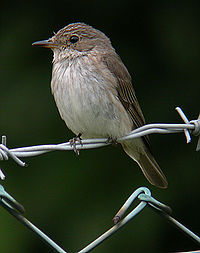
Family: Muscicapidae
Old World flycatchers and chats are a large group of small passerine birds native to the Old World. They are mainly small arboreal insectivores. The appearance of these birds is very varied, but they mostly have weak songs and harsh calls. There 274 species worldwide and 15 species which occur in Gibraltar.
- Spotted FlycatcherSpotted FlycatcherThe Spotted Flycatcher, Muscicapa striata, is a small passerine bird in the Old World flycatcher family. It breeds in most of Europe and western Asia, and is migratory, wintering in Africa and south western Asia. It is declining in parts of its range....
Muscicapa striata - European Pied FlycatcherEuropean Pied FlycatcherThe Pied Flycatcher, Ficedula hypoleuca, is a small passerine bird in the Old World flycatcher family, one of the four species of Western Palearctic black-and-white flycatchers. It breeds in most of Europe and western Asia. It is migratory, wintering mainly in western Africa. It hybridizes with...
Ficedula hypoleuca - Red-breasted FlycatcherRed-breasted FlycatcherThe Red-breasted Flycatcher is a small passerine bird in the Old World flycatcher family. It breeds in eastern Europe and across central Asia and is migratory, wintering in south Asia. It is a regular passage migrant in western Europe, whereas the Collared Flycatcher which breeds further west is...
Ficedula parva (A) - European RobinEuropean RobinThe European Robin , most commonly known in Anglophone Europe simply as the Robin, is a small insectivorous passerine bird that was formerly classed as a member of the thrush family , but is now considered to be an Old World flycatcher...
Erithacus rubecula - Common Nightingale Luscinia megarhynchos
- BluethroatBluethroatThe Bluethroat is a small passerine bird that was formerly classed as a member of the thrush family Turdidae, but is now more generally considered to be an Old World flycatcher, Muscicapidae...
Luscinia svecica - Rufous-tailed Scrub-Robin Cercotrichas galactotes
- Black RedstartBlack RedstartThe Black Redstart Phoenicurus ochruros is a small passerine bird in the redstart genus Phoenicurus. Like its relatives, it was formerly classed as a member of the Thrush family , but is now known to be an Old World flycatcher .-Description:The Black Redstart is 13–14.5 cm in length and 12–20...
Phoenicurus ochruros - Common RedstartCommon RedstartThe Common Redstart , or often simply Redstart, is a small passerine bird in the redstart genus Phoenicurus...
Phoenicurus phoenicurus - WhinchatWhinchatThe Whinchat Saxicola rubetra is a small migratory passerine bird breeding in Europe and western Asia and wintering in Africa.Its scientific name means "small rock-dweller", in reference to its habitat...
Saxicola rubetra - European StonechatEuropean StonechatThe European Stonechat is a small passerine bird that was formerly classed as a subspecies of the Common Stonechat. Long considered a member of the thrush family Turdidae, genetic evidence has placed it and its relatives in the Old World flycatcher family Muscicapidae.It is 11.5–13 cm long and...
Saxicola rubicola - Black WheatearBlack WheatearThe Black Wheatear, Oenanthe leucura, is a wheatear, a small passerine bird that was formerly classed as a member of the Thrush family Turdidae, but is now more generally considered to be an Old World flycatcher, Muscicapidae....
Oenanthe leucura (A) - Northern WheatearNorthern WheatearThe Northern Wheatear or Wheatear is a small passerine bird that was formerly classed as a member of the thrush family Turdidae, but is now more generally considered to be an Old World flycatcher, Muscicapidae...
Oenanthe oenanthe - Black-eared WheatearBlack-eared WheatearThe Black-eared Wheatear is a wheatear, a small migratory passerine bird that was formerly classed as a member of the Thrush family Turdidae, but is now more generally considered to be an Old World flycatcher, Muscicapidae....
Oenanthe hispanica - Desert WheatearDesert WheatearThe Desert Wheatear is a wheatear, a small passerine bird that was formerly classed as a member of the Thrush family Turdidae, but is now more generally considered to be an Old World flycatcher, Muscicapidae....
Oenanthe deserti (A)
Long-tailed tits
Order: PasseriformesFamily: Aegithalidae
Long-tailed tits are a group of small passerine birds with medium to long tails. They make woven bag nests in trees. Most eat a mixed diet that includes insects. There are 9 species worldwide and 1 species which occurs in Gibraltar.
- Long-tailed TitLong-tailed TitThe Long-tailed Tit or Long-tailed Bushtit is a common bird found throughout Europe and Asia. There are several extensive accounts of this species, most notably Cramp and Perrins, 1993; Gaston, 1973; and Harrap and Quinn, 1996...
Aegithalos caudatus (A)
Tits
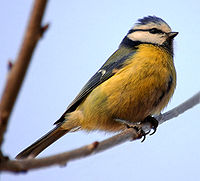
Family: Paridae
The Paridae are mainly small stocky woodland species with short stout bills. Some have crests. They are adaptable birds, with a mixed diet including seeds and insects. There are species 59 worldwide and 4 species which occur in Gibraltar.
- Coal TitCoal TitThe Coal Tit, Periparus ater, is a passerine bird in the tit family Paridae. It is a widespread and common resident breeder throughout temperate to subtropical Eurasia and northern Africa. The Spot-winged Tit The Coal Tit, Periparus ater, is a passerine bird in the tit family Paridae. It is a...
Periparus ater (A) - Crested TitCrested TitThe Crested Tit, Lophophanes cristatus , is a passerine bird in the tit family Paridae. It is a widespread and common resident breeder in coniferous forests throughout central and northern Europe and in deciduous woodland in France and the Iberian peninsula...
Lophophanes cristatus (A) - Great TitGreat TitThe Great Tit is a passerine bird in the tit family Paridae. It is a widespread and common species throughout Europe, the Middle East, Central and Northern Asia, and parts of North Africa in any sort of woodland. It is generally resident, and most Great Tits do not migrate except in extremely...
Parus major - Blue TitBlue TitThe Blue Tit is a 10.5 to 12 cm long passerine bird in the tit family Paridae. It is a widespread and common resident breeder throughout temperate and subarctic Europe and western Asia in deciduous or mixed woodlands...
Cyanistes caeruleus
Wallcreeper
Order: PasseriformesFamily: Tichodromidae
The Wallcreeper is a small bird with stunning crimson, grey and black plumage, related to the nuthatch
Nuthatch
The nuthatches are a genus, Sitta, of small passerine birds belonging to the family Sittidae. Characterised by large heads, short tails, and powerful bills and feet, nuthatches advertise their territory using loud, simple songs...
family.
- WallcreeperWallcreeperThe Wallcreeper is a small passerine bird found throughout the high mountains of Eurasia. It is the only member of the genus Tichodroma.-Taxonomy and etymology:...
Tichodroma muraria
Treecreepers
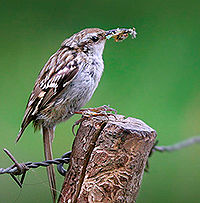
Family: Certhiidae
Treecreepers are small woodland birds, brown above and white below. They have thin pointed down-curved bills, which they use to extricate insects from bark. They have stiff tail feathers, like woodpeckers, which they use to support themselves on vertical trees. There are 6 species worldwide and 1 species which occurs in Gibraltar.
- Short-toed TreecreeperShort-toed TreecreeperThe Short-toed Treecreeper, Certhia brachydactyla, is a small passerine bird found in woodlands through much of the warmer regions of Europe and into north Africa. It has a generally more southerly distribution than the other European treecreeper species, the Common Treecreeper, with which it is...
Certhia brachydactyla
Old World orioles
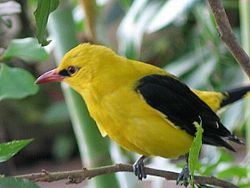
Family: Oriolidae
The Old World Orioles are colourful passerine birds. They are not related to the New World orioles. There are 29 species worldwide and 1 species which occurs in Gibraltar.
- Eurasian Golden Oriole Oriolus oriolus
Shrikes
Order: PasseriformesFamily: Laniidae
Shrikes are passerine birds known for their habit of catching other birds and small animals and impaling the uneaten portions of their bodies on thorns. A typical shrike's beak is hooked, like a bird of prey. There are 31 species worldwide and 4 species which occur in Gibraltar.
- Red-backed ShrikeRed-backed ShrikeThe Red-backed Shrike is a carnivorous passerine bird and member of the shrike family Laniidae.English common names include 'Wariangle' and 'worrier'.-Description:...
Lanius collurio (A) - Southern Grey ShrikeSouthern Grey ShrikeThe Southern Grey Shrike, Lanius meridionalis, is a member of the shrike family.It is closely related to the Great Grey Shrike, Lanius excubitor, with which it used to be considered conspecific; where they co-occur, they do not interbreed and are separated by choice of habitat.The race L. m....
Lanius meridionalis (A) - Masked ShrikeMasked ShrikeThe Masked Shrike, Lanius nubicus, is a member of the shrike family Laniidae. It breeds in southeastern Europe and the eastern end of the Mediterranean, with a separate population in western Iran. It is a common species in Turkey, Cyprus, Israel and Syria...
Lanius nubicus (A) - Woodchat ShrikeWoodchat ShrikeThe Woodchat Shrike is a member of the shrike family Laniidae.The Woodchat breeds in southern Europe, the Middle East and northwest Africa, and winters in tropical Africa. It breeds in open cultivated country, preferably with orchard trees and some bare or sandy ground.This migratory medium-sized...
Lanius senator
Crows, jays, ravens and magpies

Family: Corvidae
Corvidae
Corvidae is a cosmopolitan family of oscine passerine birds that contains the crows, ravens, rooks, jackdaws, jays, magpies, treepies, choughs and nutcrackers. The common English names used are corvids or the crow family , and there are over 120 species...
The Corvidae family includes crow
Crow
Crows form the genus Corvus in the family Corvidae. Ranging in size from the relatively small pigeon-size jackdaws to the Common Raven of the Holarctic region and Thick-billed Raven of the highlands of Ethiopia, the 40 or so members of this genus occur on all temperate continents and several...
s, raven
Raven
Raven is the common name given to several larger-bodied members of the genus Corvus—but in Europe and North America the Common Raven is normally implied...
s, jay
Jay
The jays are several species of medium-sized, usually colorful and noisy, passerine birds in the crow family Corvidae. The names jay and magpie are somewhat interchangeable, and the evolutionary relationships are rather complex...
s, chough
Chough
The Red-billed Chough or Chough , Pyrrhocorax pyrrhocorax, is a bird in the crow family; it is one of only two species in the genus Pyrrhocorax...
s, magpie
Magpie
Magpies are passerine birds of the crow family, Corvidae.In Europe, "magpie" is often used by English speakers as a synonym for the European Magpie, as there are no other magpies in Europe outside Iberia...
s, treepie
Treepie
The treepies comprise four closely related genera of long-tailed passerine birds in the family Corvidae...
s, nutcracker
Nutcracker (bird)
The nutcrackers are a genus of two species of passerine bird, in the family Corvidae, related to the jays and crows. One, the Spotted Nutcracker , occurs in Europe and Asia, the other, Clark's Nutcracker , in western North America.The most important food resources for both these species are the...
s, and ground jay
Ground jay
The ground jays or ground choughs belong to a distinct group of the passerine order of birds in the genus Podoces of the crow family Corvidae...
s. Corvids are above average in size for the bird order Passeriformes. Some of the larger species show high levels of learning behavior. There are 120 species worldwide and 8 species which occur in Gibraltar.
- Eurasian JayEurasian JayThe Eurasian Jay is a species of bird occurring over a vast region from Western Europe and north-west Africa to the Indian Subcontinent and further to the eastern seaboard of Asia and down into south-east Asia...
Garrulus glandarius - Eurasian Magpie Pica pica
- Red-billed ChoughRed-billed ChoughThe Red-billed Chough or Chough , Pyrrhocorax pyrrhocorax, is a bird in the crow family; it is one of only two species in the genus Pyrrhocorax...
Pyrrhocorax pyrrhocorax (A) - Yellow-billed Chough Pyrrhocorax graculus
- Eurasian Jackdaw Corvus monedula
- House CrowHouse Crowthumb|300px|Bangalore, IndiaThe House Crow , also known as the Colombo Crow is a common bird of the Crow family that is of Asian origin but now found in many parts of the world, where they arrived assisted by shipping. It is between the Jackdaw and the Carrion Crow in size but is relatively...
Corvus splendens (A) - Carrion CrowCarrion CrowThe Carrion Crow is a member of the passerine order of birds and the crow family which is native to western Europe and eastern Asia.-Taxonomy:...
Corvus corone (A) - Common RavenCommon RavenThe Common Raven , also known as the Northern Raven, is a large, all-black passerine bird. Found across the northern hemisphere, it is the most widely distributed of all corvids...
Corvus corax
Starlings

Family: Sturnidae
Starlings are small to medium-sized passerine birds. Their flight is strong and direct, and they are very gregarious. Their preferred habitat is fairly open country. They eat insects and fruit. Plumage is typically dark with a metallic sheen. There are 125 species worldwide and 2 species which occur in Gibraltar.
- European StarlingEuropean StarlingThe Common Starling , also known as the European Starling or just Starling, is a passerine bird in the family Sturnidae.This species of starling is native to most of temperate Europe and western Asia...
Sturnus vulgaris - Spotless StarlingSpotless StarlingThe Spotless Starling Sturnus unicolor is a passerine bird in the starling family Sturnidae. It is closely related to the Common Starling S. vulgaris, but has a much more restricted range, confined to the Iberian Peninsula, northwest Africa, southernmost France, and on the islands of Sicily,...
Sturnus unicolor
Weavers and allies
Order: PasseriformesFamily: Ploceidae
The weavers are small passerine birds related to the finch
Finch
The true finches are passerine birds in the family Fringillidae. They are predominantly seed-eating songbirds. Most are native to the Northern Hemisphere, but one subfamily is endemic to the Neotropics, one to the Hawaiian Islands, and one subfamily – monotypic at genus level – is found...
es. They are seed-eating birds with rounded conical bills. The males of many species are brightly coloured, usually in red or yellow and black, some species show variation in colour only in the breeding season. There are 116 species worldwide and 4 species which occur in Gibraltar.
- Village WeaverVillage WeaverThe Village Weaver , also known as the Spotted-backed Weaver or Black-headed Weaver , is a species of bird found in much of sub-Saharan Africa...
Ploceus cucullatus (I, A) - Red-headed QueleaRed-headed QueleaThe Red-headed Quelea is a species of bird in the Ploceidae family.It is found in Angola, Benin, Botswana, Burkina Faso, Burundi, Cameroon, Central African Republic, Chad, Republic of the Congo, Democratic Republic of the Congo, Ivory Coast, Equatorial Guinea, Ethiopia, Gabon, Gambia, Ghana,...
Quelea erythrops (I, A) - Red-billed QueleaRed-billed QueleaThe Red-billed Quelea is the world's most abundant wild bird species, with an estimated adult breeding population of 1.5 billion pairs. Some estimates of the overall population have been as large as 10 billion...
Quelea quelea (I, A) - Black-winged Bishop Euplectes hordeaceus (I, A)
Waxbills and allies
Order: PasseriformesFamily: Estrildidae
The estrildid finch
Estrildid finch
The estrildid finches are small passerine birds of the Old World tropics and Australasia. They can be classified as the family Estrildidae , or as a sub-group within the family Passeridae, which also includes the true sparrows....
es are small passerine birds of the Old World tropics and Australasia
Australasia
Australasia is a region of Oceania comprising Australia, New Zealand, the island of New Guinea, and neighbouring islands in the Pacific Ocean. The term was coined by Charles de Brosses in Histoire des navigations aux terres australes...
. They are gregarious and often colonial seed-eaters with short thick but pointed bills. They are all similar in structure and habits, but have a wide variation in plumage colours and pattern. There are 141 species worldwide and 2 species which occur in Gibraltar.
- Black-rumped WaxbillBlack-rumped WaxbillThe Black-rumped Waxbill is a common species of estrildid finch found in Southern Africa. It has an estimated global extent of occurrence of 2,000,000 km²....
Estrilda troglodytes (I, A) - Common WaxbillCommon WaxbillThe Common Waxbill , also known as the St Helena Waxbill, is a small passerine bird belonging to the estrildid finch family. It is native to sub-Saharan Africa but has been introduced to many other regions of the world and now has an estimated global extent of occurrence of 10,000,000 km²...
Estrilda astrild (I, A)
Buntings and New World sparrows

Family: Emberizidae
Emberizidae
The Emberizidae are a large family of passerine birds. They are seed-eating birds with a distinctively shaped bill.In Europe, most species are called buntings. In North America, most of the species in this family are known as sparrows, but these birds are not closely related to the sparrows, the...
The emberizids are a large family of passerine birds. They are seed-eating birds with a distinctively shaped bill. In Europe, most species are named as buntings. In North America, most of the species in this family are known as Sparrows, but these birds are not closely related to the Old World sparrows which are in the family Passeridae. Many emberizid species have distinctive head patterns. There are species 275 worldwide and 9 species which occur in Gibraltar.
- YellowhammerYellowhammerThe Yellowhammer, Emberiza citrinella, is a passerine bird in the bunting family Emberizidae. It is common in all sorts of open areas with some scrub or trees and form small flocks in winter....
Emberiza citrinella - Pine BuntingPine BuntingThe Pine Bunting, Emberiza leucocephalos, is a passerine bird in the bunting family Emberizidae, a group most modern authors now separate from the finches, Fringillidae.-Breeding and habitat:...
Emberiza leucocephalos (A) - Cirl BuntingCirl BuntingThe Cirl Bunting , Emberiza cirlus, is a passerine bird in the bunting family Emberizidae, a group now separated by most modern authors from the finches, Fringillidae....
Emberiza cirlus - Rock BuntingRock BuntingThe Rock Bunting, Emberiza cia, is a passerine bird in the bunting family Emberizidae, a group now separated by most modern authors from the finches, Fringillidae.- Range :...
Emberiza cia - Ortolan BuntingOrtolan BuntingThe Ortolan, or Ortolan Bunting, Emberiza hortulana, is a bird in the bunting family Emberizidae, a passerine family now separated by most modern authors from the finches, Fringillidae...
Emberiza hortulana - Reed BuntingReed BuntingThe Reed Bunting, Emberiza schoeniclus, is a passerine bird in the bunting family Emberizidae, a group now separated by most modern authors from the finches, Fringillidae....
Emberiza schoeniclus (A) - Corn BuntingCorn BuntingThe Corn Bunting, Miliaria calandra, is a passerine bird in the bunting family Emberizidae, a group now separated by most modern authors from the finches, Fringillidae...
Emberiza calandra - White-throated SparrowWhite-throated SparrowThe White-throated Sparrow is a passerine bird of the American sparrow family Emberizidae.-Description:The White-throated Sparrow is a passerine bird of the American sparrow family Emberizidae...
Zonotrichia albicollis (A) - Dark-eyed JuncoDark-eyed JuncoThe Dark-eyed Junco is the best-known species of the juncos, a genus of small grayish American sparrows. This bird is common across much of temperate North America and in summer ranges far into the Arctic...
Junco hyemalis (A)
Cardinals and allies
Order: PasseriformesFamily: Cardinalidae
The cardinals are a family of passerine birds that are robust, seed-eating birds, with strong bills. They are typically associated with open woodland. The sexes usually have distinct plumages. There are 43 species worldwide and 1 species which occurs in Gibraltar.
- Indigo BuntingIndigo BuntingThe Indigo Bunting, Passerina cyanea, is a small seed-eating bird in the family Cardinalidae. It is migratory, ranging from southern Canada to northern Florida during the breeding season, and from southern Florida to northern South America during the winter. It often migrates by night, using the...
Passerina cyanea (A)
New World blackbirds
Order: PasseriformesFamily: Icteridae
The icterids are a group of small to medium, often colourful, passerine birds restricted to the New World and include the grackle
Grackle
Grackle can refer to any of eleven black passerine birds native to North and South America. All are members of the Icterid family but belong to multiple genera.* Genus Quiscalus** Boat-tailed Grackle, Quiscalus major...
s, New World blackbird
New World blackbird
The New World blackbirds consist of 26 species of icterid birds that share the name blackbird but do not correspond with a formal taxon...
s, and New World oriole
New World oriole
New World orioles, comprising the genus Icterus, are a group of birds in the blackbird family. They are not related to Old World orioles which are in the family Oriolidae, but are strikingly similar in size, diet, behaviour and in their strongly contrasting plumage, and are a good example of...
s. Most species have black as the predominant plumage colour, often enlivened by yellow, orange or red. There are 98 species worldwide and 1 species which occurs in Gibraltar.
- BobolinkBobolinkThe Bobolink is a small New World blackbird and the only member of genus Dolichonyx.-Description:Adults are 16–18 cm long with short finch-like bills. They weigh about . Adult males are mostly black, although they do display creamy napes, and white scapulars, lower backs and rumps...
Dolichonyx oryzivorus (A)
Finches

Family: Fringillidae
Finch
Finch
The true finches are passerine birds in the family Fringillidae. They are predominantly seed-eating songbirds. Most are native to the Northern Hemisphere, but one subfamily is endemic to the Neotropics, one to the Hawaiian Islands, and one subfamily – monotypic at genus level – is found...
es are seed-eating passerine birds, that are small to moderately large and have a strong beak, usually conical and in some species very large. All have 12 tail feathers and 9 primaries. These birds have a bouncing flight with alternating bouts of flapping and gliding on closed wings, and most sing well. There are 137 species worldwide and 12 species which occur in Gibraltar.
- ChaffinchChaffinchThe Chaffinch , also called by a wide variety of other names, is a small passerine bird in the finch family Fringillidae.- Description :...
Fringilla coelebs - BramblingBramblingThe Brambling, Fringilla montifringilla, is a small passerine bird in the finch family Fringillidae.- Etymology :The common English name is probably derived from the German "brâma", meaning bramble or a thorny bush. It has also been called the Cock o' the North and the Mountain Finch.- Description...
Fringilla montifringilla - Common RosefinchCommon RosefinchThe Common Rosefinch is the most widespread and common rosefinch of Europe, where it has spread westward from Asia in recent decades: it has even been recorded breeding in England once...
Carpodacus erythrinus (A) - Red Crossbill Loxia curvirostra
- European GreenfinchEuropean GreenfinchThe European Greenfinch, or just Greenfinch, Carduelis chloris, is a small passerine bird in the finch family Fringillidae. The genus Carduelis might be split up and in this case, the greenfinches would be separated in their old genus Chloris again.This bird is widespread throughout Europe, north...
Carduelis chloris - Eurasian SiskinEurasian SiskinThe Eurasian Siskin is a small passerine bird in the finch family Fringillidae. It is also called the European Siskin, Common Siskin or just Siskin. Other names include Black-headed Goldfinch, barley bird and aberdevine. It is very common throughout Europe and Asia...
Carduelis spinus - European GoldfinchEuropean GoldfinchThe European Goldfinch or Goldfinch is a small passerine bird in the finch family.-Habitat and range:The goldfinch breeds across Europe, North Africa, and western and central Asia, in open, partially wooded lowlands. It is resident in the milder west of its range, but migrates from colder regions...
Carduelis carduelis - Eurasian Linnet Carduelis cannabina
- European SerinEuropean SerinThe European Serin, or just Serin is the smallest European species of the family of finches and is closely related to the Canary. Its diet consists mainly of a combination of buds and seeds.-Description:...
Serinus serinus - Eurasian BullfinchEurasian BullfinchThe Bullfinch, Common Bullfinch or Eurasian Bullfinch is a small passerine bird in the finch family Fringillidae. In Anglophone Europe it is known simply as Bullfinch, as it is the original bird to bear the name bullfinch.This bird breeds across Europe and temperate Asia...
Pyrrhula pyrrhula - HawfinchHawfinchThe Hawfinch, Coccothraustes coccothraustes, is a passerine bird in the finch family Fringillidae. Its closest living relatives are the Evening Grosbeak from North America and the Hooded Grosbeak from Central America especially Mexico.This bird breeds across Europe and temperate Asia...
Coccothraustes coccothraustes (A) - Trumpeter FinchTrumpeter FinchThe Trumpeter Finch is a small passerine bird in the finch family Fringillidae.This bird breeds in the Canary Islands, across north Africa, and in the Middle East and into central Asia. There is a small European population in southern Spain...
Bucanetes githaginea (A)
Sparrows
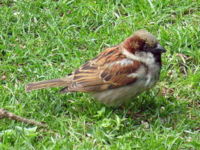
Family: Passeridae
Sparrow
Sparrow
The sparrows are a family of small passerine birds, Passeridae. They are also known as true sparrows, or Old World sparrows, names also used for a genus of the family, Passer...
s are small passerine birds. In general, sparrows tend to be small, plump, brown or grey birds with short tails and short powerful beaks. Sparrows are seed-eaters, and they also consume small insects. There are 35 species worldwide and 3 species which occur in Gibraltar.
- House SparrowHouse SparrowThe House Sparrow is a bird of the sparrow family Passeridae, found in most parts of the world. One of about 25 species in the genus Passer, the House Sparrow occurs naturally in most of Europe, the Mediterranean region, and much of Asia...
Passer domesticus - Spanish SparrowSpanish SparrowThe Spanish Sparrow or Willow Sparrow is a passerine bird of the sparrow family Passeridae. It is found in the Mediterranean region and southwest and central Asia...
Passer hispaniolensis - Eurasian Tree Sparrow Passer montanus
See also
- List of birds
- Lists of birds by region
- List of mammals in Gibraltar
- List of reptiles and amphibians in Gibraltar

